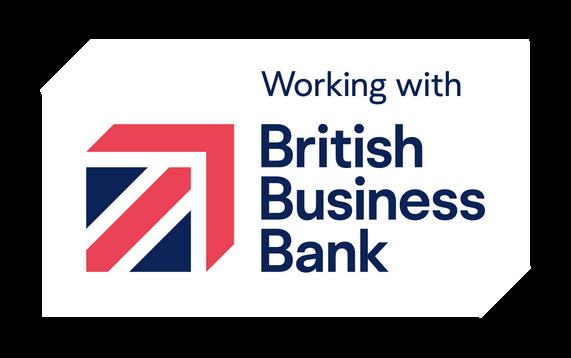
Readiness to borrow
Picking the right season, not just the right seed












































Picking the right season, not just the right seed











































Special features
20 Allica Bank: A quiet transformation
NACFB: Readiness to borrow
Colenko: Complexity introduces time
NACFB: And the winners are…
48 ART Business Loans: Lost in the shuffle
iwoca: At the turning point
TRIVER: Bridging the festive cash flow gap
Metro Bank: The ‘forgotten middle’
Roma Finance: From stopgap to strategy Opinion & commentary 60 Rural & Business Specialists (R&BS): Cultivating success
Hilco Real Estate: The broker’s advantage
Coventry & Warwickshire Reinvestment Trust: Championing the regions 66 Somo: Beyond the deal
68 GB Bank: Further afield
70 Triodos Bank: Five things brokers should know about ethical lending
72 Five minutes with: Playter’s Jamie Beaumont From problem-solver to coach Andrea O’Brien on Haydock, brokers, and why creating space for others matters most
Kieran Jones Editor & Feature Writer Kieran.Jones@nacfb.org.uk
Jenny Barrett Communications Consultant Jenny.Barrett@nacfb.org.uk
Laura Mills Communications Manager Laura.Mills@nacfb.org.uk
Sophie Olejnik
Digital Marketing Executive Sophie.Olejnik@nacfb.org.uk
Amber Jane Roye
Graphic Designer Amber-Jane.Roye@nacfb.org.uk
Samantha Scales
Graphic Designer Samantha.Scales@nacfb.org.uk
Magazine Advertising 0207 101 0359 magazine@nacfb.org.uk




Jim Higginbotham Chief Executive Officer
NACFB
You catch us in a reflective mood. My first twelve months as CEO have seen significant developments for both the Association and the market we serve, and as the year closes, it feels right to pause and take stock.
As I flick through this final edition of Commercial Broker for the year, I’m struck by how strongly it captures that same spirit of reflection. It brings together an array of perspectives from across our community – brokers, lenders, and strategic stakeholders – each offering up-to-the-minute insight into the issues shaping SME finance. The result is a publication that not only reports on the sector, but also seeks to give it a collective voice.
Our cover feature explores the concept of readiness to borrow and reminds us that timing, preparation, and judgment often matter more than product alone. In a market still adjusting to higher rates and tighter conditions, brokers are proving their value by guiding clients towards finance that supports growth rather than strain.
We also share really encouraging news from the NACFB Mutual. By leaning into one of the true benefits of mutuality, we have been able to return money directly to the pockets of Members who hold PI cover through the Association. At a time when costs remain under pressure, this is a tangible example of collective strength working for the good of each firm.
And, of course, this issue celebrates the winners and highly commended firms from last month’s Commercial Broker Awards Their achievements are a reminder that excellence continues to shine across our industry, even in demanding conditions.
Looking ahead, our roster for 2026 is ambitious, and it builds on the strong platform created this year. Thank you for your continued support throughout 2025 – it has made my first year in post both rewarding and energising. I look forward to what we can achieve together in the year ahead.

Delay kills opportunity. And that’s why we’re here. Reward is the original alternative business lender. We collaborate with enterprising businesspeople who need timely decisions that set their plans in motion. rewardfunding.co.uk

The NACFB Mutual, now in its third year of trading, has confirmed it will deliver its first round of loyalty-based fee reductions to qualifying Members upon renewal. This benefit, built into the very design of the Mutual, ensures that surpluses are returned directly to Members.
Qualifying Members will see a 15% loyalty rebate applied at their next renewal, reflecting contributions made during the Mutual’s first trading cycle (the initial period of cover for those who joined at launch). To be eligible, brokers must have held cover from the outset of that cycle, have renewed continuously since, and have made no claims or notified any circumstances that could give rise to a claim. The rebate will be netted off at renewal rather than paid separately, ensuring the benefit is felt immediately in reduced renewal costs.
This marks the first phase of a core commitment built into the Mutual from the outset: that any trading surpluses should be shared fairly among its Members. The first phase of that benefit
is now being realised. This approach ensures that the advantages of mutuality – fairness, transparency, and Member ownership – are felt directly by those who supported the Mutual from the outset and who continue to renew their cover.
Alongside this development, the underlying insurer backing the Mutual has recently been upgraded to an A-rated provider, First Underwriting Limited, giving Members added comfort and long-term peace of mind.
Launched to tackle the escalating cost of PI insurance, the NACFB Mutual has consistently delivered meaningful savings. Members have seen up to 30% reductions on first-year renewal contributions compared with other providers. Today, four in five NACFB Members are now covered by the Mutual – a testament to its effectiveness and growing reputation across the broker community.
Unlike conventional insurers, the Mutual also has the flexibility to respond to circumstances outside standard policy wordings, reflecting the day-to-day realities faced by both property-focused
and business and asset finance brokers.
Chair of the NACFB Mutual, Adrian Coles, commented: “The Mutual was founded on the principle that Members should share directly in its success. This first round of loyalty-based reductions marks a significant step in delivering on that promise. Coupled with the security of an A-rated insurance backer, the Mutual continues to set the benchmark for fair, reliable, and Member-focused cover.”
Martin Richards, a director at Tower Insurance Brokers, the team that manages the NACFB Mutual, said: “The Mutual was built on fairness and transparency. Rebates are linked to Members’ original contributions and reviewed annually by the board, so while not guaranteed each year, they ensure that whenever conditions allow, Members directly share in the success of the Mutual.”
The NACFB Mutual remains open to all qualifying broker firms within the Association. Member firms with upcoming PI renewals are encouraged to visit nacfb.org/mutual
We’re a specialist business bank focused on commercial and buy-to-let mortgages for experienced property landlords, investors and British SMEs. Meet our Business Development Team

Andre Parcian Head of Business Development North East, Midlands & Wales



Mark Dobson Head of Business Development South & London
Ian Tudor Regional Development Manager South and South West
Sue Young Regional Development Manager South East

Jane Hand
Regional Development Manager North East
07741 140338 andre.parcian@redwoodbank.co.uk
07920 585222
mark.dobson@redwoodbank.co.uk
07443 966050
ian.tudor@redwoodbank.co.uk
07789 587633 sue.young@redwoodbank.co.uk
07879 174887
jane.hand@redwoodbank.co.uk
Read our latest product guide here


From smarter criteria, expert support and cash back rewards, we’re helping landlords go further.
READ ABOUT HOW REDWOOD SUPPORTS AND DELIVERS FOR OUR CUSTOMERS.
When a client belonging to award-winning brokers B2B Finance wanted to refinance a development loan they had used to upgrade a block of flats worth more than £1.2m, the brokerage firm turned to Redwood Bank and its solicitors, Knights, to handle the complex deal.
Properties involved: 11 remaining flats in Wrexham worth £1.22m (originally 24 flats, half already sold).
Legal challenge: Properties held on two defective leasehold titles; client also owned the freehold.
Solution:
Redwood Bank and solicitors Knights resolved title and lease issues.
Knights acted as dual rep solicitor for efficiency
Loan details: £934,065 loan, 76.5% LTV, 20-year interest-only term.
Purpose: Deal qualified for Green Cashback Reward due to EPC ratings of C.
Redwood Bank is one of our most trusted lending partners, with a clear understanding of the needs of experienced property investors. Their specialist approach and ability to handle complex cases really set them apart.
Rebecca Jones, B2B Finance
Let Redwood help YOU with your specialist lending needs.






Seven key policy moves that could unlock growth for SMEs – and new opportunities for brokers


Dave Furnival Head of Broker NatWest
The sight of the Chancellor’s red despatch box at this time of year brings with it a mix of anticipation and concern – and for brokers, Rachel Reeves’ upcoming Budget could be especially significant.
Despite a black hole in the country’s finances that’s estimated to hover around the £40 billion mark, she has promised an “investment-first” approach, and if she gets it right, there’s real potential to give small and medium-sized enterprises (SMEs) the oxygen they need to grow. This could boost confidence of SMEs up and down the country to invest in their futures and mean more opportunities for UK brokers and finance professionals.
Laying out one of the central themes of her autumn Budget recently, Chancellor Reeves said the Government would aim to improve the productive capacity of the economy, allocate higher investment into infrastructure, and redefine planning rules.
“If renewal is our mission and productivity is our challenge, then investment and reform are our tools,” she said, setting a determined tone.
So, if investment and growth are the goals, what would a broker’s Budget wish list look like? Here are a few practical moves the Chancellor could make.
1. Enhance capital allowances with a focus on SMEs
In her last Budget, the Chancellor maintained the Government’s full expensing scheme to encourage capital expenditure by larger companies. Broadening its scope to make full expensing more widely available and offering allowances for investments in productivity-enhancing equipment, could drive a wave of borrowing and leasing activity amongst SMEs.
2. Smarter tax reliefs for growth businesses
Extending or enhancing reliefs for R&D, digital investment, or energy efficiency could free up capital for SMEs to expand.
For brokers, that could translate into a larger pool of businesses seeking advice and finance packages.
One of the biggest headaches for SMEs is late payment. The Chancellor could strengthen the Fair Payment Code or enforce tighter standards on big corporations to settle invoices quickly. This would improve cash flow in the SME sector, making small businesses more “finance ready,” boosting demand for broker-arranged funding solutions.
Brokers and their clients spend too much time navigating red tape. A targeted review of financial promotions rules or reporting requirements for smaller brokerages could help them focus less on box-ticking and more on serving customers.
Extending tax incentives for investment zones or offering specific grants for regional SME hubs could spread growth across the country. That creates new networks for brokers to tap into, ensuring finance flows to where it’s most needed.
Business rates are set to rise in April 2026 for premises with rateable values over £500,000. Although this increase is primarily aimed at large distribution warehouses used by online retailers, it is also likely to affect bricks-and-mortar retail, hospitality, and leisure (RHL) businesses with similarly valued premises. Freezing business rates at current levels for these businesses could give them much-needed breathing space to reinvest.
The Chancellor will be walking a tightrope in her Budget speech – balancing fiscal responsibility with the need to kick-start growth. For brokers, the priorities of strengthening SMEs, making capital more accessible, and improving efficiency in the system would be outcomes we could all get behind.
Want to talk to us about how we could support you? Email us on brokerteam@natwest.com
From funding growth initiatives to investment in capital equipment or infrastructure, our Unsecured Business Loans can help SMEs to boost growth and move their businesses forwards.
Highlights:
• Loans from £25k – £250k
• 1 – 5 year terms
• No arrangement fee (£200 doc fee applies)
• Simple, online application process
• Assisted auto-decisioning for more challenging or complex deals
• Same day pay-outs*
*Once approved, where all required info is received by 12pm.

Interested in working with us? Get in touch
FOR INTERMEDIARIES ONLY
The Treasury is reconsidering a proposed increase in landfill tax following significant backlash from industry leaders. The plans, which aimed to eliminate exemptions and reduce rates, were revealed unexpectedly, causing anger among sectors like housebuilding and construction. Currently set at £126.15 per tonne, the tax could see costs for large housebuilders rise dramatically. One industry source noted: “They are still trying to get a grip on the impact and implications of the reforms.”
FCA finds insurers short-changing drivers
The Financial Conduct Authority (FCA) has identified that around 270,000 drivers are owed £200 million in compensation due to insurers undervaluing vehicles during claims for theft or write-offs. The FCA’s review prompted insurers to amend their claims processes. So far, £129 million has been paid to nearly 150,000 customers. Sarah Pritchard, FCA’s deputy chief executive, said: “We’ll step in when consumers aren’t getting fair value – and we are pleased to see that the practices which led to some unfair payouts have already changed.”

Landlords dismiss tax hike suggestions
The National Residential Landlords Association (NRLA) has rejected the Joseph Rowntree Foundation’s (JRF) analysis suggesting that tax hikes on the private rented sector have aided first-time buyers. The JRF report claims that reforms since 2016 have led to 1.1 million more households owning homes. However, NRLA chief executive, Ben Beadle, stated: “The idea that higher taxes are good for renters is simply not correct.” He warned that further tax increases would dampen investment and push rents higher. The JRF supports closing tax loopholes for landlords to promote homeownership.
Reeves tells investors she wants to ‘take out more regulators’
The Chancellor has announced plans to reduce the number of regulators in the UK to stimulate economic growth. Speaking at the British Private Equity & Venture Capital Association summit, Rachel Reeves said: “I want to take out more regulators; there’s still too many.” She highlighted recent actions, including the dismissal of the Competition and Markets Authority chair and constraints on the Financial Ombudsman Service.
The Prudential Regulation Authority (PRA) has proposed significant regulatory cuts to ease the banking sector’s operational burdens. The plan includes eliminating 37 overlapping reporting templates, which could save banks approximately £26 million annually. The regulator said the changes would not compromise its “primary objective” of ensuring the safety and soundness of firms.

UK economy falters with 50,000 job losses
The latest flash PMI from S&P Global has warned that growth in the UK’s private sector had slowed to its weakest level in the three months to September as higher business costs led to “subdued” demand and further job cuts. Manufacturing output has dropped to a six-month low, while the service sector struggles with constrained spending. Some 50,000 job losses were also reported in the three-month period. Chris Williamson, chief business economist at S&P Global Market Intelligence, said: “Alarm bells should be ringing that the economy is faltering.” Despite these issues, the PMI index remains above 50, indicating modest growth.
The Organisation of Economic Co-operation and Development (OECD) has increased its forecast slightly for UK growth this year from 1.3% to 1.4%, but predicts a fall again to 1% next year, unchanged from previous forecasts. Inflation in the UK is expected to hit 3.5%, up from its previous estimate of 3.1%, falling to 2.7% in 2026. Chancellor Rachel Reeves responded saying the figures “confirm that the British economy is stronger than forecast.” But Shadow Chancellor Sir Mel Stride said the OECD confirmed “what hard-working families already feel - under Labour, Britain is in a high tax, high inflation, low growth doom loop.”












We have a specialist understanding of the following key sectors: Community Faith Healthcare Social Housing Reliance Bank wins

Reliance Bank prioritise business lending to organisations that deliver positive social impact in the UK.
We outperform high street banks for customer satisfaction
Reliance Bank have been awarded FIRST place overall in the 2025 Charity Finance Banking Survey!
Reliance Bank also achieved first place in the following categories:




Helping good people do great things with
Reliance Bank has been at the forefront of socially responsible banking since 1890, when we were founded as the bank for The Salvation Army.


We provide:









Loans for refinancing
Loans for business acquisition
Loans for property purchase
Loans for refurbishment
Loans for business expansion


A commitment to the broker market and SME lending

Brian Cartwright Head of Broker BPCE Equipment Solutions
BPCE Equipment Solutions has built its reputation in the UK market, over the last 27 years, by forging strong partnerships – especially with brokers.
I’m excited to lead the next phase of our growth in the UK, ensuring our broker partners are fully supported and empowered to deliver value to their clients
Our longevity and resilience through difficult economic times are integral to who we are and our support of our partners. As we continue to expand our footprint in the UK, we remain committed to the markets we serve and to supporting SMEs across all sectors through meaningful relationships and tailored funding solutions.
Our success is driven by the strategic leadership of our UK executive team and the deep industry expertise within our business. We’re proud to offer brokers the support they need for every type of transaction.
A key part of our service model is access to our commercially minded expert teams who work closely with brokers to structure deals that benefit all parties, especially where those deals are more complex. Fast, transparent decision-making and hands-on support throughout the deal lifecycle are central to how we operate.
As the newly appointed head of broker, I bring years of experience in the broker market and a deep understanding of the challenges brokers face. I’m excited to lead the next phase
We actively listen to broker feedback to refine our product suite and credit appetite, to ensure brokers have the tools they need to deliver fast, effective, and client-focused funding solutions

of our growth in the UK, ensuring our broker partners are fully supported and empowered to deliver value to their clients.
Following our recent acquisition by Groupe BPCE, we’re ready to be part of their ambition to become Europe’s leading provider of equipment lease financing. This milestone opens new opportunities for us to expand our asset finance lending in the UK.
We’re investing in systems and people to strengthen our reach across diverse sectors, with broker-led growth forming a key part of our strategy in the years ahead.
The broker-lender relationship: Evolving with purpose
The broker market is evolving, with a growing emphasis on collaboration, transparency, and shared values. Successful partnerships today go beyond pricing – they’re built on trust and responsiveness.
We actively listen to broker feedback to refine our product suite and credit appetite, to ensure brokers have the tools they need to deliver fast, effective, and client-focused funding.
We believe there’s a real opportunity to bridge the funding gap with flexible asset finance terms that give businesses the confidence to move forward. We value our relationships with brokers and consider our real value is in providing the right solutions that help brokers invest and grow.
A typical deal: From proposal to drawdown
Speed, clarity, and communication are at the heart of our process. A typical deal begins with a broker submitting a proposal via our portal or account manager. Our team assesses the opportunity and delivers a credit decision –often within four to 48 hours, depending on complexity.
Once approved, our operations and documentation teams work closely with brokers to finalise paperwork, verify assets, and complete due diligence. Drawdown is typically completed within 24 hours, ensuring a smooth and professional experience for clients.
The UK SME sector remains a vital engine of economic growth – despite facing challenges such as interest rates, inflationary pressures, and political uncertainty which continue to weigh on confidence. Yet, despite these headwinds, many businesses are still investing in equipment to modernise operations, and boost productivity, and they need reliable funding partners to do so.
At BPCE Equipment Solutions, we’re committed to being that kind of lender – relationship driven, service-focused, and ready to support the growth and success of the broker community.
Our hope is that lenders, brokers, and trade bodies like the NACFB continue working together to support SMEs with access to fair, responsible, and innovative funding.
The role of the broker has never been more important. As demand for tailored asset finance grows, so does the need for trusted lenders who act quickly, think commercially, and treat brokers as true partners.
Speed, clarity, and communication are at the heart of our process

Sarah Cunningham Head of Compliance NACFB
Acommon refrain from NACFB Members is that the FCA simply doesn’t understand credit broking. That perception has often been reinforced by the kind of data the regulator collected in the past. Through the old GABRIEL returns, the information submitted was considered rudimentary at best and some viewed it did little to reflect the real nuances of a broker’s work.
In a bid to change that, and to make better assessments of whether firms are using their permissions appropriately, the FCA has sought to improve the way it gathers information. The introduction of a new consumer credit return is their attempt to do just that – collecting clearer, more relevant data that should, in theory, help the regulator gain a sharper picture of the sector.
Whether this shift genuinely leads to a deeper understanding of credit broking remains to be seen. But what is clear is that it marks a step in the right direction, with the regulator wanting to learn and understand more about credit broking. So, what exactly will the changes look like – and, crucially, what do brokers need to do about them?
The new consumer credit return will apply to firms with permissions for credit broking, debt adjusting, debt counselling, or credit information services. It introduces five universal sections – permissions, business model, marketing, revenue, and sales staff – followed by tailored questions depending on the permissions you hold. This ‘branching logic’ should keep the return more relevant to your business model.
The new return also replaces some of the existing data items. For example, CCR004 (Debt Management Firms) and CCR005 (Client Money & Assets) have been retired, with CCR009 introduced in their place. The idea is to reduce duplication and simplify what firms need to submit. In total, the prototype was reduced by almost a third after direct feedback from the NACFB, meaning brokers will face fewer questions and less duplication than first proposed.
So, what do the changes mean in practice? The answer will depend on whether you operate as an independent firm or as a principal with appointed representatives (ARs).
Independent firms will need to complete the new return directly via RegData, ensuring they report accurately against their own
Anyone who has spoken to me this year will know that a common source of confusion is knowing what is a regulated, exempt, or unregulated transaction

Make sure you also understand your deals, and know which transactions fall within regulated, exempt, or unregulated categories, as this will directly affect what you report
permissions. For many smaller firms, this will mean collating data manually or from spreadsheets – which can be time-consuming, but the questions should now be simpler to match to business activity.
Principal firms with ARs carry added responsibility. Principals must report not only their own activity but also that of their AR network. The FCA has published a series of flow diagrams to clarify this process, but in practice, it means principals will need reliable reporting systems from their ARs to avoid inconsistencies.
Anyone who has spoken to me this year will know that a common source of confusion is knowing what is a regulated, exempt, or unregulated transaction. This distinction matters because it determines both how you handle the agreement and what you submit for your reg data submission.
Lending of less than £25,000 with a business purpose is regulated by the Consumer Credit Act when it is provided to a regulated customer (individuals, sole traders, partnerships of two or three people, or unincorporated associations that do not include a corporate body and is not a partnership).
For the business exemption to apply to a regulated customer, three conditions must all be met: the loan must be for more than £25,000, the funds must be used wholly or mainly for business purposes, and the business exemption declaration within the finance agreement must be signed. Only when all three conditions are satisfied does the deal become exempt. At the point a broker introduces a customer to a lender, the customer is still treated as regulated.
Limited companies, LLPs, and partnerships of four or more people are treated as non-regulated customers and therefore fall outside the scope of the Consumer Credit Act.
It’s important to remember that your FCA submissions need to include regulated and exempt deals. Just because
an exempt deal is signed up on non-regulated paper doesn’t mean it shouldn’t be submitted. The FCA also wants you to include proposed deals that have been declined.
For most NACFB Members, the practical steps are straightforward. Begin by checking your permissions – only firms with the relevant credit permissions will need to complete the new return. Review how you currently collect data: if you rely on manual spreadsheets, consider whether that will remain sustainable. Make sure you also understand your deals, and know which transactions fall within regulated, exempt, or unregulated categories, as this will directly affect what you report.
The new consumer credit return now applies to all firms with


permissions for credit broking, debt adjusting, debt counselling, or credit information services. If your reporting period ended after May 2025, you will already be required to complete the new return. Others will encounter it as their current cycle closes. Submissions continue to be made via RegData, but the FCA has indicated it may look to better align reporting cycles in future. The NACFB will seek to provide guidance and templates to support Members in adapting and continue to work closely with the FCA regarding these returns.
The Association will continue to monitor how the new return is implemented, challenge inconsistencies, and press for fair treatment of brokers. With the right preparation, and with the NACFB compliance team on hand to help, Members can approach the new return with confidence rather than concern.










the future, rather than being shaped by it
From shifting customer expectations to the latest in digital transformation, the asset finance landscape is evolving fast. To unpack what this means for brokers and lenders, we put questions to Jason Hurwitz, Sales Director Europe at NETSOL Technologies – who shares his views on where the sector is heading.
Brokers are under more pressure than ever to get commission disclosure right. What makes this such a challenging area in practice?
The industry was upended and went through a painful period of adapting to full commission disclosure post the High Court ruling in October. As is too often the case, businesses rush to remain on the right side of compliance and legal requirements, but positive customer experience falls down the priority list. It’s now not uncommon for a borrower to be in receipt of three or more disclosure documents through the journey of taking on finance, with varying language and terms. Part of this may be inevitable as the shape of a deal, particularly more complex lending cases, can change materially through the course of accessing funding. In more simple cases, this repeated disclosure could do the very opposite of its designed intention, risking creating more ambiguity and damaging confidence.
If disclosures are handled poorly, what are the risks for brokers?
When disclosures are mishandled –whether through omission, ambiguity or delay, the consequences can be
severe. Beyond reputational damage and regulatory penalties, brokers face the risk of deals being unwound or challenged retrospectively, undermining both trust and profitability. At NETSOL, we believe technology must play a central role in de-risking this process. Automated, auditable disclosure not only ensures compliance, but also strengthens borrower (and lender) confidence – something the industry cannot afford to overlook.
How does the Supreme Court’s decision on commission practices impact on the operational and compliance needs of brokers and asset finance companies, and how is NETSOL positioned to support them?
The Supreme Court’s decision offers some relief to lenders and brokers, but it also reinforces the need for more rigorous and demonstrable compliance and documentation practices. Even though many historic claims may now fall away, the spotlight remains firmly on commission transparency –especially as the FCA prepares a redress scheme for excessive discretionary arrangements. What is clear is that without a tech supported customer journey with an audit trail, brokers and lenders will find they experience material disruption and distraction to business growth activities in having to manually gather data and documentation to evidence fair and compliant practices.
At NETSOL, we’re uniquely positioned to support this shift. Our solutions are designed with built-in compliance controls, customisable customer

Jason Hurwitz Sales Director Europe NETSOL Technologies
journeys, commission visibility and real-time audit trails. This ensures our clients can avoid material business disruption, adapt quickly to regulatory expectations in hours, while strengthening trust with partners and customers alike.
In light of the ruling, what specific features or capabilities in NETSOL’s platform can help brokers and lenders futureproof their businesses?
NETSOL’s origination platform is highly adaptable and flexible, allowing brokers and lenders to customise their workflows to tailor to today’s unique needs and regulatory demands of different customer segments, all in one platform. Our clients can continue to tailor customer journeys at speed to ensure they respond quickly to market changes and fast-evolving compliance requirements, futureproofing their operations.
Our solutions and partnership ensure both lenders and brokers need never stand still or be stuck in one solution that is inflexible and hard to adapt. We unlock business agility for our clients, along with reducing risk.
Following the previous Court of Appeal ruling on commission disclosure, our innovative portals for lenders and brokers ensured compliance for Haydock Finance with zero disruptions to their operations. These compliance system changes were delivered in record time – just 36 hours. We enabled clear disclosure documentation to be sent to customers with one click, seamless integration into existing processes, and, as mentioned, no operational disruptions.





There’s an understandable scepticism among brokers currently about AI. For all the hype and bluster, it may not always be clear how AI is positively impacting the broker or borrower experience. For many, it may feel like quite the opposite.
Indeed, a recent survey of Allica’s broker panel revealed that over half of commercial mortgage and bridging brokers feel that technology, including AI, has either had no notable impact or even had a negative impact on the speed or efficiency of processing applications.
With 51% reporting a positive experience, asset finance brokers appear to have had a slightly better experience of technology’s impact, but this was still only a narrow majority.
I can understand this scepticism. When it comes to interacting with banks, many people’s practical experiences of AI don’t extend beyond a rather frustrating chatbot whose only mission seems to be to stand between you and someone who can actually help.
But at banks like Allica, there is in fact a quiet transformation taking place behind the scenes, which warrants unpacking.
I often hear stories about banks cutting down on the human element of their service as they look to reduce overheads. This is often because their people are the simplest cost to cut, as their legacy back office is simply too embedded to change.
At Allica, we do things the other way around. We understand how much brokers and businesses value a real person interaction.
So, we have remained committed to giving our brokers the real human support of their business development manager. And instead, we invest heavily in automating everything that sits behind that human interaction. Making our people more effective, decisions faster, and providing a smoother experience overall for the broker and their client.
The saying goes that: “If it has ‘AI’ in the name, it’s probably not real AI. Real AI is the stuff you don’t notice.”
And this is exactly my experience here at Allica. Our market-leading tech team has implemented AI tools into our processes in ways that may not be apparent to the end user – our broker community and their clients – but are transforming the overall experience. I’ll outline a few ways that’s already happening at Allica now.
Our current commercial mortgage application processing time is around just two days, while asset finance is four hours. Far beyond the industry average. Turnaround times like this help our brokers meet tight deadlines and service clients promptly.
We understand how much brokers and businesses value a real person interaction

From automating decisions, to speeding up underwriting, to improved communication and greater transparency, AI means commercial finance will be a different beast just a few years from now
AI is a big reason for this efficiency. Our underwriters use AI to read documents and process unstructured data, cutting down processing times by as much as 75%. This then means we have more time to spend assessing the nuanced risks in an application and better tailor our offers to your clients.
Preventing ‘ping-pong’ applications
We’re working on an AI system that checks applications when they’re submitted in real-time for missing information. This will alert the broker instantly about what we need, saving a back and forth with our team, and streamlining the process overall.
decisions (to a point)
Our automated decisioning for asset finance is one of the clearest examples I can give of AI improving service delivery.
Our machine learning system assesses applications in real-time, automatically approving, referring or declining them based on creditworthiness, affordability and policy. This means that decisions that previously took 24 hours have become just one minute, giving welcome certainty to brokers and their clients as quickly as we can. After all, a fast no is always more helpful than a long maybe.
Importantly, we only automate decisions where it’s black and white. Anything nuanced still goes to a real underwriter. We also only currently run this system on relatively low value assets (<£50,000). We expect to roll this out to six- or seven-figure applications after further testing and fine-tuning.
In a world where many banks are putting up technological barriers between them and their brokers and customers, Allica is doing things the other way around.
The possibilities for transforming the lending experience – and supporting an even greater number of businesses as a result –go far beyond my imagination. From automating decisions, to speeding up underwriting, to improved communication and greater transparency, AI means commercial finance will be a different beast just a few years from now. And I am delighted that, as the UK’s fastest-growing fintech, Allica is at the vanguard of this movement.
But I know that whatever avenues Allica does go down, the human relationship that we know our brokers value will always be a core component.

Picking the right season, not just the right seed

Kieran Jones Head of Communications & Advocacy NACFB
FIn a market that prizes speed, the ability to slow down at the right moments is what makes you fast overall
armers don’t harvest because they own a combine. They harvest because the crop is ready. Try a week too soon and you leave yield in the field. Leave it too long and wind, rain, or pests do the damage for you. In a sense, commercial borrowing works the same way. The tools matter, but timing decides the outcome. In the post-pandemic market, where rates are higher and for many cash buffers are thinner, the brokers who win are the ones who read the season, not just the product sheet. They are the ones that help clients avoid a ‘now or never’ mentality, prepare for ‘not yet’ and move at the moment when debt genuinely supports progress rather than smothering it.
The headline numbers tell you why this matters. The UK now counts more than 5.6 million registered businesses, with record new formations in 2023 and again in 2024. Challenger banks and fintechs have widened routes to capital. Yet approvals for day-to-day finance still trail pre-2020 levels. That gap, is in large part, down to readiness. It shows up when directors ask for speed whilst their filings are late, when bank statements broadcast strain, when personal credit jars with the business case, or when a startup wants a facility before it can show a steady pulse in the numbers. Sometimes it takes discipline and longer term thinking as an intermediary to work with a customer and help them on their journey to readiness. The easy route can be to follow the path of least resistance and offer a quick fix, but

if that fix doesn’t meet the real needs of the customer or creates unnecessary strain on the business then trust in the intermediary is eroded. The very best brokers build solid solution-based relationships as opposed to unstable loan stacks.
So,
Readiness is not just a buzzword. In essence, it’s the alignment of three things at a point in time: a clear purpose for the money, numbers that prove the business can carry the debt, and people whose conduct supports the story. Purpose stops you selling a fast fix to a slow problem. Numbers – in filed accounts, clean bank statements, stable gross margin, believable forecasts –turn hope into evidence. The personal element, including the director’s own credit, now carries greater weight than many owners expect. Lenders price behaviour because it predicts resilience when trading gets choppy.
Readiness is also not the same as access. A firm can find offers and still not be ready to accept one without regret three months later. It is also not a moral judgement on a founder or a team. It’s a judgement on today and that distinction matters. Owners who hear ‘not yet’ with a clearly defined solution and pathway return. Owners who hear a vague ‘no’ often disappear and join the ranks of permanent non-borrowers.
Many brokers see a version of the same early stage request each week. A new retailer or online brand feels the tug of demand and wants inventory finance three months after launch. The story is encouraging, but the evidence is thin. There’s no pattern across seasons. The director’s personal file may be thin rather than bad, which still trips risk appetite. A facility at this point is likely to be expensive and brittle. It turns a promising business into a borrower who checks the bank app every hour and sleeps with a knot in their stomach. Step back and six to nine months of clean trading, on-time filings, direct debits that prevent missed payments, and a simple cash rhythm transform the same request. Suddenly a revolving line mapped to receivables makes sense. Same business. Same lender universe. Just a different season.
The same early mistake shows up in sectors with lumpy revenue too. Contractors reach for quick cash products to bridge gaps between milestones before they’ve proved how the calendar really flows. A single project delay then collides with daily or weekly repayments. An account that never comes to rest looks risky to every funder who sees it. Here again, the ‘not yet’ discipline buys
time to match tenor to cycle and to build acceptance gates for new work that protect margin. The eventual facility is cheaper and less stressful because it fits how cash actually arrives.
At the other end of the scale, you’re likely to meet businesses that wait until pressure is obvious, then ask for a single injection to reset. Maybe trading has been slow, and they have wages to pay or a one-off payment to a supplier becomes due. There are many fast, friction free options available to receive a short-term cash injection which when used correctly can be just the help that’s needed. However, too often these options are not thought through, are more expensive than expected and can end up acting like a tourniquet. It stops the bleeding, then starves the limb. Serviceability becomes challenging and what was a short-term fix turns into a long-term problem. Such a problem is compounded when similar solutions are sought to ease serviceability. The loans stack up, leverage increases, and growth is stifled.
This is where brokers have a responsibility to truly understand their customers’ business and financing needs. Where understanding the investment plans, the working capital cycle and the seasonality of the business can help recommend the most appropriate debt structure. Often restructuring pre-existing loans into more appropriate debt solutions, reducing serviceability burdens and creating a strong long-term foundation for growth.
None of this pays off if brokers act like a product rep. Finance professionals right across the NACFB membership sit in the only seat that sees both the owner’s ambition and the lender caution. Use this position of privilege wisely. Guide your customer through the various stages of financial maturity and the associated debt solutions that become available at each
Owners who experience a thoughtful ‘not yet’ with dates, milestones, and a review point come back

stage. Help them tell their story in a way that is both compelling and transparent to a lender.
Taking this relationship-based long-term approach creates real equity with and for customers and lenders alike. Owners who experience a thoughtful ‘not yet’ with dates, milestones, and a review point come back. Lenders who meet you through files that are clean and stories that are honest remember you. Reciprocity grows. Your pipeline improves because referrals track toward prepared businesses. Your reputation with credit teams strengthens because you don’t flood them with noise. In a market that prizes speed, the ability to slow down at the right moments is what makes you fast overall.
Reading the file like a lender
Journalists talk about ‘writing to length’, brokers need ‘reading to risk’. The file tells you if the season is right in plain cues. On-time filings signal discipline. Bank statements show the heart rate: credits, seasonality, concentration risk, rejected payments. Management accounts show whether margin holds when volumes change. Forecasts matter only if they tether to the drivers you can point at – orders, recurring revenue, confirmed contracts, or footfall that justifies a staffing plan.
Then there’s the director’s personal file. Treat it as a business variable, not a private footnote. Small changes – clearing minor balances, fixing outdated addresses, putting all regular bills on direct debit can all help. Owners rarely know that. You do. Tell them, give them a checklist, and set a date to review. You are not being paternalistic. You are closing the loop between behaviour and price.
Timing, shown not told
Real names aren’t needed to make the point, but brokers encounter examples of this tension frequently. Consider this, a young brand with strong engagement but little trading history wants a cash boost for stock. The early offer is costly and unforgiving. You decline with a plan: live bookkeeping, monthly management accounts, a minimum of two clean quarters, and a target date. When you revisit, the facility size is smaller than the original dream but fits the rhythm of receivables and costs less. Timing, not access, changed the answer.
A hospitality group carries legacy support debt and short-term advances stacked during a bad winter. Cash cover fails under a modest stress. Rather than add another layer, you rebuild the weekly cash routine, negotiate with the two biggest creditors, and close during loss-making hours. Ninety days later, the cover
test passes, and a more suitable debt structure that matches the needs of the business cycle can be put in place. The products existed on both days, but the readiness did not.
A contractor leans on quick cash to bridge between milestones and ends up with three repayments a week. You map the debt stack, match tenor to cycle, and add go/no-go rules for low-margin work. A single facility replaces three, the account calms, and the lender relationship becomes a conversation rather than a fire drill. Same tools. Different sequence.
These are timing stories, and they prove an unfashionable point: saying ‘no, not yet’ can be the most commercial thing you do.
If doing the right thing at the right time is going to be the competitive differentiator moving forward you need to make sure you build purpose, affordability and behaviour – the three pillars of readiness – into your firm’s DNA. Do your diligence, understand the business, think what will help now, tomorrow and in the future. Build trust and a lasting relationship. Help your customer pull together the right evidence to support a credit request and start to build that trust with the lenders. After a decline, write a short memo that explains the why, the what next, and the when. Diary the review before you hang up. Then measure what matters. Track how many warm declines return within six months and fund on better terms. Track time-to-yes for prepared files versus rushed files. Share those numbers in your team. Culture follows metrics.
The payoff is practical. Conversations improve. Files move faster. Your team spends less time firefighting and more time guiding. Clients notice and so will lenders, your brokerage will become known not for the size of your database but for the quality of your delivery.
Brokers don’t control all the variables, but they can help guide customers through their path to readiness and beyond. The job isn’t finding the quick fix its more about finding the right solution at the right time and having the confidence to wait and prepare rather than rush and fail. Too early and debt outruns the evidence. Too late and it turns into a tourniquet. Choose the right moment and debt works as a lever. Serve the client and the lender, and you earn repeat business and faster decisions.
That is the harder path to take, a trickier long game. Readiness is a broker’s craft. Timing is your edge. Use both to turn good firms into resilient borrowers, short calls into lasting partnerships, and one completion into a client for years.


































































































































Andre Parcian Head of Business Development (Midlands and Wales) Redwood Bank
Specialist lending is still sometimes seen as the place where unusual or difficult deals end up. In reality, what brokers are handling day-to-day shows that these so-called ‘specialist’ scenarios are widespread. Clients with property transfers into companies or trusts or plans to expand through HMOs (houses of multiple occupation) and mixed-use properties are no longer exceptions. They’re becoming a significant part of mainstream business.
Human underwriters can weigh up context, apply judgement and speak directly with brokers about the nuances of a case
That shift means specialist lending isn’t a side-line. It’s a core part of the lending landscape. Take a look at the types of clients brokers are dealing with today. Yes, there are still plenty of ‘vanilla’ cases – straightforward buy-to-lets or commercial loans with clean credit histories. But there’s also been a steady rise in cases that don’t line up neatly with standard criteria.
Examples include landlords transferring properties into limited companies for tax efficiency or trusts being used as part of succession. I’ve also seen people in mid-life careers – teachers, doctors, civil servants – stepping away from their day jobs to build property portfolios instead. None of these scenarios are unusual anymore. But they do create challenges for lenders who rely solely on rigid, rules-based systems.

Mainstream banks absolutely still play an important role. If a client ticks every box, they can often provide the cheapest and quickest solution. But when those boxes aren’t ticked, the high street can be unforgiving.
That’s where specialist lending comes in. What defines this part of the market isn’t a willingness to take reckless risks, but rather an ability to look at cases in the round. Borrower experience, structure and long-term viability often matter as much as a single number on a spreadsheet. For brokers, having that option can be the difference between progressing a deal or seeing it collapse.
One of the distinguishing features of specialist lending is the role of manual underwriting. Some might see that as old-fashioned in today’s world of technology, but in practice it’s often the best way to deal with real-world complexity.
Automated systems are efficient, but they struggle when a case involves moving properties between entities, managing the credit worthiness of multiple applicants or when the asset involved is a large HMO or semi-commercial unit. Human underwriters can weigh up context, apply judgement and speak directly with brokers about the nuances of a case.
That dialogue is hugely valuable. It means brokers aren’t just submitting an application into a black box – they’re part of a conversation.
The specialist sector has also been adjusting to today’s affordability challenges. Across the market, changes to how affordability is assessed have opened the door to deals that might previously have stalled. In some cases, targeted adjustments to cost deductions and the option of higher fee structures for lower interest rates have allowed landlords, particularly those with HMOs and semi-commercial properties, to achieve higher loan-to-value ratios than before. In practice, this can mean a refinancing case releases tens of thousands more in available borrowing, or that a portfolio expansion which looked impossible suddenly becomes viable.
Keeping on top of these shifts can unlock opportunities for clients at a time when margins are tight and yields are under pressure.
Specialist doesn’t mean slow
One misconception that persists is the idea that specialist lenders will take any deal, at any risk, for the right price. A poor-quality case won’t cut the mustard with any lender. All lenders, including specialists, must have robust credit policies. What changes with a specialist is the willingness to look beyond rigid thresholds, the opportunity to have a conversation about the case and to consider the bigger picture.
This is where a broker’s role is vital. The better a deal is articulated, the easier it is for underwriters to make balanced decisions. In that sense, specialist lending is not a shortcut; it’s a partnership.
It’s also important to stress that specialist doesn’t mean slow. Lenders in this space are investing in technology to accelerate early-stage checks and give brokers faster clarity. More sophisticated credit referencing tools, for example, can flag potential hurdles at the very start, saving wasted effort.
Looking ahead, I expect technology to become even more embedded. AI will no doubt streamline parts of the process. But I don’t see human judgement disappearing. If anything, as cases become more complex, the combination of efficient tech and experienced underwriters will be even more critical.
For brokers, the lesson is simple: don’t think of specialist lending as an emergency option. Think of it as part of the core toolkit. Clients today come with diverse backgrounds, ambitions and financial structures. High-street criteria alone can’t cater for that variety. By working closely with specialist lenders, brokers can expand their options, strengthen client relationships and ensure that deals keep moving even when the straightforward route isn’t available.

Understanding the need for fast, and not so fast, bridging finance

Mark Marlow Head of Sales Colenko
Bridging finance has long carried a reputation for speed. Marketed as a swift, flexible alternative to traditional lending, it’s often positioned as the go to solution when time is of the essence. Whether that is for seizing a property auction opportunity, resolving a chain break, or unlocking capital tied up in an asset. But, as the bridging market has matured, so too has its complexity. And for brokers, the reality is this: not all bridging loans are fast.
Today, bridging spans a wide and increasingly nuanced spectrum of products. Some deals still complete in a matter of days. Others, particularly those involving heavy refurbishment, complex corporate structures, or specialist security can take weeks, if not months. The challenge for brokers is clear: how do you manage client expectations in a market where ‘bridging’ no longer guarantees speed?
There’s no doubt that fast bridging still exists and thrives. For the right deal, a straightforward residential purchase with clean title and cooperative vendors, funds can be released in 48 to 72 hours.
In these cases, speed is driven by:
• Simple ownership structures – individual or joint borrowers
• First-charge security on residential or mixed-use property
• Clear exit strategy – such as refinance or resale
• Cooperative third parties – such as vendors, legal teams, valuers
• Experienced borrowers with strong profiles.
As a broker, identifying these opportunities early and working with lenders who specialise in quick completions is key. But they represent just one end of the bridging spectrum.
On the other end are the more complex facilities often described as ‘heavy’ bridging. These may include:
• Development or refurbishment finance – especially where planning permission is involved
• Second-charge or multiple security arrangements
• Corporate borrowers, trusts, or offshore ownership
• Unusual property types or non-standard valuations
• Adverse credit or regulatory concerns.
Heavy bridging resembles structured lending more than the fast-and-flexible solution many clients imagine. Valuations might take a week or more. QS reports, environmental checks or monitoring surveyors may be required. Legal due diligence becomes more involved. Underwriting takes longer, not due to inefficiency, but because the risk profile is fundamentally different.
For brokers, it’s crucial to explain to clients that complexity introduces time. The phrase ‘bridging is fast’ is only true when the deal allows for it.
Several trends have contributed to the diversification of bridging timelines:
• Increased lender competition has led to product innovation, expanding what bridging can cover
• Borrower sophistication has increased – clients are using bridging not just for urgency, but as part of broader investment strategies
• Risk appetite has widened meaning lenders now take on more complex deals that naturally require more due diligence.
In other words, bridging has evolved. It’s no longer a one-size-fits-all emergency loan. It’s a flexible, multi-purpose financial tool, but not always a quick one.
The broker’s role is to navigate this complexity, identifying when bridging can deliver speed and when it demands patience. The more brokers understand about the expanding world of bridging the better equipped they are to pair the right deal with the right lender and to set their clients up for success.





Lancashire Cricket Club at Emirates Old Trafford, Manchester, was brimming with energy on Friday 19th September as it played host to the largest-ever NACFB Commercial Broker Awards.
A record 580 guests from across the industry gathered to celebrate broking excellence, cheering as winners were crowned across 24 coveted categories. This year saw a surge in engagement, with 357 award entries submitted – marking a 22% increase in submissions and a 25% rise in participating NACFB Member firms.
The ceremony was fronted by comedian Jayde Adams, whose sharp wit kept the momentum flowing and the audience entertained. One of the most poignant moments of the afternoon came when Paul Slapa, founder of the NACFB’s 2025 charity partner, The Unbeatable Eva Foundation, shared his deeply personal story. The room was visibly moved, before rallying together for a game of Heads and Tails that raised £4,000 in support of the cause.
Reflecting on his first NACFB Commercial Broker Awards as CEO, Jim Higginbotham said: “These awards not only highlight the very best in broking but also celebrate the firms that are pushing boundaries and helping to shape the future of our industry.
I’m immensely proud that the NACFB sits at the heart of such a thriving community.”
All shortlisted firms, highly commended entries and overall winners were decided upon by combining the insights of an expert judging panel and votes from Patron lenders and Partner suppliers.
The winners and highly commended in each category are:
Asset & Leasing Finance Broker of the Year (1 to 3 brokers)
Winner: Claratus Commercial Finance
Highly commended: Synergi Finance
Sponsor: Ultimate Finance
Asset & Leasing Finance Broker of the Year (4+ brokers)
Winner: Moorgate Finance
Highly commended: Bathgate Business Finance
Sponsor: Haydock Finance
Buy-to-Let Mortgage Broker of the Year (1 to 3 brokers)
Winner: VIBE Finance
Highly commended: Advanced Funding Solutions
Sponsor: Paragon Bank
Buy-to-Let Mortgage Broker of the Year (4+ brokers)
Winner: Aria Finance
Highly commended: SPF Private Finance
Sponsor: Keystone Property Finance
Cashflow Finance Broker of the Year (1 to 3 brokers)
Winner: Synergi Finance
Highly commended: Claratus Commercial Finance
Sponsor: Reward Funding
Cashflow Finance Broker of the Year (4+ brokers)
Winner: Halo Corporate Finance
Highly commended: Leonard Curtis
Sponsor: Funding Circle
Commercial Broker Network of the Year
Winner: Synergy Commercial Finance
Highly commended: Fiducia Commercial Network and Vaughans
Sponsor: YBS Commercial Mortgages


Commercial Mortgage Broker of the Year (1 to 3 brokers)
Winner: Ross
Commercial Finance
Highly commended: Aquilae Capital Advisory
Sponsor: Cambridge & Counties Bank

Commercial Mortgage Broker of the Year (4+ brokers)
Winner: Watts Commercial Finance
Highly commended: Leonard Curtis
Sponsor: Lloyds Bank
Development Finance Broker of the Year (1 to 3 brokers)
Winner: Willow Isle Capital
Highly commended: Positive Commercial Finance
Sponsor: LendInvest
Development Finance Broker of the Year (4+ brokers)
Winner: Real Finance
Highly commended: Arc & Co. Sponsor: LBB
Industry Ambassador of the Year
Winner: Kim McGinley – VIBE Finance
Highly commended: James Murray – James Murrary Finance
Sponsor: HSBC

Industry Specialist of the Year
Winner: Approved Business Finance
Highly commended: Crown Business Finance
Sponsor: Allica Bank
Invoice Finance Broker of the Year (1 to 3 brokers)
Winner: Evolve Business Finance
Highly commended: DMK Finance
Sponsor: HSBC
Invoice Finance Broker of the Year (4+ brokers)
Winner: Leonard Curtis
Highly commended: TSF Finance
Sponsor: Ultimate Finance
Unsung Hero of the Year
Winner: Mickaella Johnson - Tower Leasing
Highly commended: Barbara Curzon
- Watts Commercial Finance
Sponsor: Close Brothers Broker Solutions
Northern Irish Broker of the Year
Winner: RM Commercial Finance
Highly commended: Ross Commercial Finance
Sponsor: NACFB
Scottish Broker of the Year
Winner: Ross Commercial Finance
Highly commended: DMK Finance
Sponsor: Hampshire Trust Bank


Welsh Broker of the Year
Winner: Pure Property Finance
Highly commended: Watts Commercial Finance
Sponsor: Roma Finance
Pioneering Broker of the Year
Winner: Lime Finance Solutions

Highly commended: Clifton Private Finance
Sponsor: NatWest
Rising Star of the Year
Winner: Kevin Calkiewicz – Charles & Dean Finance
Highly commended: George Sanford – VIBE Finance
Sponsor: Shawbrook
Service Excellence
Winner: Watts Commercial Finance
Highly commended: Willow Isle Capital
Sponsor: Aldermore
Short-term Finance Broker of the Year (1 to 3 brokers)
Winner: Advanced Funding Solutions
Highly commended: Plutus Business Finance
Sponsor: Recognise Bank
Short-term Finance Broker of the Year (4+ brokers)
Winner: Arc & Co.
Highly commended: Propp
Sponsor: Market Financial Solutions











We’re one of the UK’s largest independent SME funders and have been providing specialist and adaptable working capital finance for over 40 years. We support businesses with improving cashflow, investing in new equipment or trading internationally through our Invoice Finance, Asset Finance and Foreign Exchange solutions. Awarded NACFB Factoring and Invoice Discounter of the Year 2024, for the second year running, we are a funding partner you and your clients can rely on.



Todd Davison Managing Director Purbeck Insurance Services
The UK Government’s recent investigation into the use of personal guarantees (PGs) for small and medium-sized business loans has brought some clarity about the future of a financing tool that’s often misunderstood by business owners and directors. With a commitment to help businesses better understand PGs, the findings suggest that the benefits outweigh the drawbacks –positioning PGs as a route to finance rather than a barrier.
Our data suggests some businesses are already buying into this message and have become more comfortable in the past year to sign personal guarantees when backed by insurance protection – July 2025 was a record month for us. One notable trend is that in Q2 2025, 16% of loans supported through Purbeck’s Personal Guarantee Insurance were for businesses under two years old – up from just 6% in Q2 2024. The average loan value for these early-stage businesses has also risen sharply, reaching £165,538 in Q2 2025 – a 52.71% increase year-on-year.
But a perception gap about personal guarantees remains. PGs are often seen as a necessary evil to be avoided at all costs, but small businesses must have some ‘skin in the game’ for lenders to take the risk of lending. Without this security there will be no lending. This perception gap is one that commercial brokers are perfectly positioned to fill with their knowledge of the risk mitigation options SMEs have at their disposal.
The recent expansion of the Growth Guarantee Scheme (GGS) is another good move but another opportunity for
misunderstandings when it comes to PGs. We have found that many SMEs mistakenly believe that the government-backed guarantee protects them directly. In reality, the guarantee protects the lender, not the borrower. Business owners are still required to sign personal guarantees for the full extent of the loan and remain liable if the business defaults. It’s vital that business owners understand the implications of signing a personal guarantee. The lender can only claim on the government-backed guarantee after exhausting all avenues –including the personal guarantee – to recover the debt.
Alongside the expansion of the GGS, the Government has announced a new mandatory Code of Conduct for accredited lenders to promote fairness and transparency in the use of PGs. Whether this clears up the common misunderstanding of borrower liability remains to be seen, but it is again an area where NACFB Members can support education and awareness.
Whilst company insolvencies have been falling, Purbeck has noted rising business failures linked to poor acquisition due diligence and the sudden withdrawal of government grants. These trends highlight the importance of risk mitigation when entering PG-backed agreements. Brokers play a vital role in guiding businesses through these complexities. By explaining the pros and cons of PGs and offering solutions like personal guarantee insurance, they can help SMEs pursue growth with confidence.
A perception












































Carolyn Asplin Head of Real Estate Lloyds Commercial Banking Intermediaries
The Real Estate Ready Loan is a new lending solution designed for commercial real estate businesses. It reflects our imperative to always listen and act on broker feedback and deliver lending solutions that truly meet what the market needs.
One of the most impactful changes this brings is lowering the minimum loan threshold to £100,000, making our lending proposition more accessible to a wider range of investors.
Whether your clients are expanding their portfolios, or entering the market for the first time, they now have access to interest-only terms – available depending on EPC qualifying criteria – alongside our existing part-amortising and fully-amortising options. This marks the first time these products have been made available at the lower lending threshold and represents an important milestone for brokers seeking tailored solutions for residential-dominant investments.
We’re also matching market standards and paying a 1.5% commission on the loan amount.
While the Real Estate Ready Loan is mainly designed for residential investments, we understand the different needs of today’s property investors. The loan therefore extends to support mixed-use properties and student/HMO accommodations, if at least 70% of the income used to service the loan is derived from residential assets.
This flexibility makes sure our offering stays relevant for clients with diverse portfolios, making it easier to secure financing for properties that blend commercial and residential uses, or for those that cater to the student and shared accommodation markets (our very first sanctioned deal was secured for a mixed-use property – a shop with flats above).
• Interest-only: from 1.15% over base rate (OBR)
• Part-amortising: from 1.28% OBR
• Fully-amortising: from 1.55% OBR
Fixed interest rates are available across all options, and a 2% arrangement fee applies.
Feedback from brokers has been overwhelmingly positive, with the straightforward process, clarity, and efficiency of getting to indicative terms resonating well.
For those clients who end up not meeting the criteria, our business development managers remain on hand to support other opportunities through the usual channels.
To get started with the Real Estate Ready Loan, please contact brokerdirect@lloydsbanking.com and the team can share more details, including a proforma that’s required for all enquiries.
Let’s help your clients make the most of this opportunity.


The UK commercial property market is in a period of change, and with change comes opportunity. For brokers, helping clients navigate shifting demand patterns and regulatory landscapes isn’t just about securing finance; it’s about uncovering hidden value in overlooked or evolving asset classes.
One of the clearest opportunities lies in portfolio diversification. Landlords are increasingly looking beyond traditional buy-to-let models and considering commercial or semi-commercial properties that can offer multiple income streams. A shop with residential flats above, for example, can provide a blend of long-term commercial lease income alongside shorter assured shorthold tenancy (AST) agreements. In some cases, the residential element can be reconfigured into a house of multiple occupation (HMO), maximising yields while spreading risk.
The value doesn’t have to be in the building as it stands today. Change-of-use strategies, such as securing planning permission to convert commercial space into residential, can transform the income profile of an asset. Even where full conversion isn’t the goal, landlords can reposition properties to meet local demand, such as splitting larger retail units into smaller, more affordable spaces for independent occupiers.
Location trends are also shifting in ways that open up new possibilities. Secondary and tertiary high streets, which may once have been overlooked in favour of large retail parks or out-of-town superstores, are enjoying renewed relevance. As hybrid working patterns take root and consumers favour local shopping, demand is rising for well-located ground-floor retail with residential above. This provides a dual benefit for investors: stable commercial tenants serving their community and high-demand residential units in walkable locations.
The office sector is another area where change is creating broker opportunities. While the pandemic prompted a wave of office-to-residential conversions, we’re now seeing a partial
return of demand for high-quality office space as firms encourage teams back into the workplace. This creates a nuanced landscape – in some cases, conversion to residential will still be the optimal route; in others, refurbishing and modernising office stock can deliver strong rental growth.
For brokers, the key is to guide clients through these options with a focus on unlocking untapped potential. That means understanding both the asset’s current income profile and its future possibilities. Financing needs will often extend beyond a straightforward purchase – refurbishment costs, planning applications, and phased redevelopments all require flexible, responsive funding solutions.
At Glenhawk, we’ve seen first-hand how strategic property repositioning can deliver exceptional returns for landlords and developers. The role of the lender is to provide the speed and certainty of funding that allows brokers’ clients to seize opportunities as they arise. Whether that’s acquiring a mixed-use property in an emerging location, converting upper floors into HMOs, or breathing new life into an under-loved high street building.
The UK commercial property market is evolving fast. For borrowers willing to look beyond the obvious, there’s enormous value waiting to be uncovered. The challenge – and the reward –lies in spotting it first.
We’re now seeing a partial return of demand for high-quality office space as firms encourage teams back into the workplace



Gemma Wright
Managing
Director – Sales & Distribution
Reward Funding
Brokers know better than most that no two SME funding journeys are the same. Needs evolve, circumstances change and priorities vary — and often, all of that can happen in the span of a single conversation. Whilst they are aware of this, even the most experienced brokers can turn to familiar lenders, rather than approaching each deal with a new outlook. It can be easy to do so, especially when a client may have an incredibly tight timeline or a complex need.
In fact, findings from the NACFB’s 2024 annual impact report found that a quarter of SMEs who secured funding through a NACFB Member broker ended up with a different product than they first enquired about – proof that initial assumptions often evolve.
We recently had a broker approach us for a straightforward bridging facility, but when we delved into the ‘why’ behind their client’s need, we structured a combined asset and business finance package that unlocked more working capital and provided a longer runway.
This demonstrates the need for brokers to challenge assumptions, take the time to address what their client is truly looking for and consider how a lender might meet those needs. Lenders too, have a duty to ensure that brokers have a clear understanding of their products and processes – including when things change – and in turn, take care to understand the needs of the broker. When these factors are in play, lenders can act decisively, shape the right facility fast and be comfortable that the best outcome is born for both the broker and the client.
By pigeonholing a lender into a narrow category, maybe thinking ‘they only do bridging deals’, or ‘they are just focused on asset finance’, brokers risk missing the nuances that make all the
difference to SMEs when picking out the right lender for the job. Lenders are constantly evolving and diversifying their offerings to reflect an increasingly complex landscape, so what a broker knew 12 months ago when they last approached the lender could be completely different to the current reality.
So how can brokers keep lending solutions dynamic?
The main answer here is to ask clients more questions. Go further than simply asking what they want the loan for. Yes, they may have cash flow issues or growth plans. But then look at the ‘why’. Why now, why those specific aims, why did the issues come about? More often than not, by looking beyond the ‘what’, brokers can open up a lot more solutions.
Alongside this, it is important that brokers revisit their understanding of lenders’ offerings on a regular basis. Taking the time to reconnect with the various lenders and familiarising themselves with current products, processes and services will pay dividends. Brokers may be surprised with what has changed in a relatively short time, especially in the fast, flexible funding space we work in.
Ultimately, a broker’s value lies in more than just sourcing the funding for a client. It is about understanding the landscape, seeing where flexibility lies and challenging initial assumptions. So, if you’re a broker and you want to keep your options wide and your client’s ambitions front and centre, we always recommend that you pick up the phone to a lender before you pick the product.
More often than not, by looking beyond the ‘what’, brokers can open up a lot more solutions


A look at market drivers, risks, and lending solutions

Marc Callaghan Head of Specialist Finance OSB Group
The owner occupier sector is going from strength to strength. According to CoStar data, in Q1 2025, the total volume of commercial property acquired for owner occupation in the UK was £2.8 billion, a significant portion of the overall £8.9 billion invested in UK commercial real estate.
On June 23rd 2025, the UK Government published its 10-year Modern Industrial Strategy aiming to boost business investment and growth in key high-growth potential areas such as advanced manufacturing, digital and technology.
If this is to be successful, then SMEs within owner occupied industrial/ warehouses and offices may need to be the driving force behind it.
June 2025 also heralded the Government’s 10-Year UK Infrastructure Strategy. With £1.35 billion of public funding now available, businesses are gaining confidence; industrial occupational demand improved by 10% during Q2 2025, and it’s hoped that this trend will continue.
Office investment also gained momentum in 2025. The sector accounted for the highest share of UK transaction volumes in H1, at 21%, according to CBRE.
Industry data from CoStar suggests that UK office take-up has risen to a three-year high and the UK office vacancy rate has stabilised (data from Avison Young), helped by a 10-year low in office construction.
In particular, the UK ‘Big Nine’ regional office cities outside of London (Birmingham, Bristol, Cardiff, Edinburgh, Glasgow, Leeds, Liverpool, Manchester and Newcastle) has seen collective take-up reach 3.7m sq ft, as highlighted by Avison Young, 6% ahead of the 10-year average.
Driven by a lack of Grade-A space in city centres, occupiers are increasingly looking out of town. Six of the 10 largest deals in H1 2025 were outside the city centre, compared with 2024 where all top 10 deals took place in city centre locations, according to Cushman & Wakefield.
With a limited construction pipeline, Cushman & Wakefield also notes, that this could place upward pressure on rents, enhancing returns and unlocking further investment activity. Improving retail sales could also be aiding retailer performance with average weekly volumes 2.3% higher during Q2 2025 compared with last year.
The owner occupier market continues to face several challenges, including economic uncertainties such as inflation and rising interest rates, which impact affordability and borrowing costs.
Additionally, a shortage of available properties, in the face of high demand, makes it difficult for potential buyers to find suitable properties. Navigating changing occupier needs, such as hybrid working patterns and the need for sustainable spaces, adds another layer of complexity.
InterBay is well-placed to help brokers and their clients navigate such intricacies. We support a variety of asset classes, from florists to children’s nurseries, distribution warehouses and small retail units.
When it comes to SMEs, we know the market, have clear criteria and our team of experts work closely with brokers to help borrowers secure the funding they need.
For instance, when reviewing cases, we:
• use the last two years’ finalised accounts so we see three years’ worth of figures;
• look at the performance of the business, the experience of the owners, and the specifics of the property; and
• aim to meet with the borrowers directly for loans over £4 million, so that we can fully understand their background and plans.
We also may look at securing on another property to help get the borrowing level required or mitigate risk in other ways. This includes requesting capital and interest payments to help bring the risk down over the term or including other assets of the business in debentures.
When reviewing accounts, we look at EBITDA (earnings before interest, taxes, depreciation, and amortisation) where necessary. This means that on occasion, despite a company reporting a loss, our affordability requirements may still be met.
In addition, we take exceptional items into consideration, such as legal costs, repairs, research and development.
Every business and property is different so we look at each loan on its merits and balance out risks (where possible) to solve clients’ complex cases.
According to latest data from CoStar, in Q1 2025, the total volume of commercial property acquired for owner occupation in the UK was £2.8 billion, a significant portion of the overall £8.9 billion invested in UK commercial real estate

Andrea O’Brien on Haydock, brokers, and why creating space for others matters most
We meet Andrea O’Brien on a late August afternoon at Haydock’s Blackburn base, tucked away on a nondescript industrial estate on the edge of town. “There’s not much round here in the way of shopping,” she laughs, “but at least there’s plenty of parking” – a line she often shares with new starters. When I mention I’d made the journey up by train from down south, she gives a knowing smile. The trip is rarely straightforward.
We settle in a nearby coffee shop, where our allotted hour inevitably stretches well beyond. Andrea is easy company: confident without being overbearing, frank in her assessments, and unafraid to share both the high points and the hard lessons of her career to date. She proudly describes herself as a “problem-solver above all else”, someone who rolls up her sleeves and gets things done.
Her journey reflects that determination. From a teenager selling perfume behind the concession stands in Debenhams to leading broker sales at one of asset finance’s most distinctive lenders, Andrea has carved her own path through persistence, instinct, and graft. Again, she talks with beaming pride of Haydock’s culture, and just as fondly of her other lifelong passion: football.
As a teenager, she idolised Blackburn Rovers captain Colin Hendry, following the team home and away as he lifted the Premier League title at Ewood Park; now, years later, Hendry is coaching her son. For Andrea, there’s a symmetry in that shift – once inspired by the pursuit of glory, she now finds just as much satisfaction in nurturing the next generation. It’s a parallel that runs through her own career at Haydock: after years spent driving growth and chasing success, her focus today is on coaching, guiding, and creating the pathways that will allow others at the NACFB Patron to reach new heights.
Tell us about your career journey – how did you move from perfume counters to asset finance?
It’s quite a shift, isn’t it? I started out in beauty therapy straight from school, but within a year I knew it wasn’t for
me. A placement at Debenhams led to a permanent role on the Yves Saint Laurent counter. At 18 I had my own concession, designer uniforms, glitzy product launches – but the hours were brutal. I was also a Blackburn Rovers season ticket holder, so trying to book Saturdays off was frowned upon. Eventually the work-life balance didn’t add up.
So, I applied for a role at Haydock Finance. This was the early ’90s, just after a management buyout, and my first job was in customer retention. I had targets, persuaded people to stay with us, and ended up being promoted again and again. I never really applied for roles –opportunities came, and I grabbed them.
You left Haydock for a while before returning. What happened in between?
I spent 11 years there first time round, moving through consumer motor finance, contract hire, even property development loans. After the financial crash, I took redundancy with two kids under two. I then worked at Academy Leasing, became an office manager within six months, and learned a huge amount about problem-solving. Later I tried my hand at internet marketing – but a career selling Google ads didn’t sit right with me.
Then John Wilkinson, Haydock’s founder, rang and said: “We don’t know what you’ll do, Andrea, but do you want to come back?” I trusted it would work out – and it did. I’ve been here since 2014, carving out my path.
Who’s influenced your leadership style most?
John Wilkinson, without doubt. He gave me opportunities I’d never have had elsewhere, and he trusted me to figure things out. I couldn’t lead exactly as he did, but the empowerment he showed has shaped me. I make decisions, back myself, and ask for forgiveness afterwards if I need to.
Now I get more satisfaction from coaching others than solving problems myself. Early on, I’d step in, fix it, and take the credit. These days, I guide people to solve it themselves. Watching them progress gives me more pride than being the hero.
Haydock recently marked its 45th anniversary. What did that milestone mean to you?
It made me reflective. I’ve seen Haydock evolve from a local motor finance firm into a genuine national player. The consistency is what sets us apart –consistent appetite, consistent product, and a culture that really does feel like family. We’ve grown but stayed true to who we are.
And personally, it’s reminded me to create a structure beneath me. My focus now is on building others up so the business is in safe hands for the next 45 years.
People often describe Haydock as having a family feel. Does that resonate?
Yes, completely. We do the usual things – planning for team socials, summer barbecues – but the culture goes deeper. There’s no blame. If something goes wrong, we ask what we could have done differently, not who to point the finger at.
Everyone pulls together. Credit will jump on a call with a broker; ops will help chase paperwork – nobody says “that’s not my job.” That’s rare, and brokers pick up on it.
What does great broker engagement look like to you?
For me it’s when we’re the first port of call for business that fits our space. Not everything, just the right things – and brokers feel confident we’ll give them a fair, commercial hearing.
I value honesty above all. If we’ve dropped the ball, I’d rather brokers told me straight. And I’ll be direct with them too. It’s probably a Northern thing, but they know where they stand with me.
What challenges do brokers face right now?
Competition is fierce. Dual proposals are everywhere, and some suppliers are setting up their own brokerages to cut out intermediaries. That’s tough if you’ve built your livelihood on those relationships.
We’ve even had vendors approach us directly but they’re underestimating the

work that brokers do. Without them, we would get poor quality proposals and high decline rates. Brokers add real value, and we’re vocal about backing them.
If a new broker asked for your advice, what would you say?
Don’t think it’s all about speed and price. New entrants often come from sales backgrounds without understanding the operational side – the KYC, the proof of title, the complexities that can hold up a deal. Without that knowledge, you risk over-promising to clients and under-delivering. Invest in learning the whole process, not just the front end. Build relationships. Play the long game.
Haydock talks about being a ‘storybook lender’. What does that mean in practice?
It means looking beyond the numbers. Our underwriters will pick up the phone, ask what’s really going on, and consider the bigger picture. If the accounts show a loss but there’s a credible story – a delayed contract, for example – we’ll listen. It’s about understanding the context, not just the credit file.
How important is speed and clarity in that process?
Huge. We’ve restructured underwriting into three streams: automation up to £70,000, flow deals up to £750,000, and complex cases above that. Our average decision times are four hours at the low end, a day for the big stuff. Payouts follow the same logic.
Brokers need clarity. Even if it’s a no,
they want to understand why. That transparency builds trust.
Haydock has put real emphasis on quality assurance recently. Can you step through this a little?
Because volume is vanity. We’ve built a data-led framework to measure proposal quality, acceptance, take-up and payout. My team works with brokers whose numbers fall short – not to beat them with a stick, but to help them improve.
The best part? Brokers have embraced it. Some even challenge their own teams now, asking why their acceptance rates aren’t higher. It’s created a culture of continuous improvement.
Commission disclosure has been a big industry debate. How have you approached it?
We kept it simple. We adopted Julian Rose’s template, which is clear and broker-friendly, and only adjusted wording around how commission is calculated. We use just three versions across the whole network. Our transactions team enforces it consistently.
Honestly, it’s been a storm in a teacup. Clients are fine with it. Brokers are fine with it. Transparency hasn’t killed the market.
Looking ahead, what excites you most about the next chapter for Haydock?
More of the same, but better. Faster decisioning, smarter use of AI, continual
improvement. Apollo [Haydock’s backers since 2018] are hugely supportive, and our strategy is steady growth with the same culture intact.
And for the broker–lender relationship?
It’s here to stay. Banks keep pulling back from SMEs, so brokers are more valuable than ever. AI can improve processes, but it can’t replace the human side. Storybook lending needs storytellers.
Finally, what does life look like outside of work?
Football dominates. My eldest, Connor, is a professional at Accrington Stanley, and I go to most games home and away. My younger son is an engineering apprentice but was a decent player too. I grew up idolising Colin Hendry at Blackburn, and now he’s coaching my son – that’s special.
Beyond football, I love holidays. I had a big birthday recently and celebrated in style – Amalfi last year, Gdansk this summer. Short breaks keep me balanced. But honestly, I feel blessed. I love my job, and I never get that Sunday dread. Not many people can say that.
Throughout our time together, Andrea spoke with a clarity and directness that cuts through the noise. Straight-talking and pragmatic, she seems to carry those qualities into her role at Haydock: loyalty, graft, and an instinct for solving problems. Yet what came through perhaps most strongly is a real shift in emphasis – from chasing results herself to building the structures and people who will deliver them in the years ahead.
Whether she’s talking about broker engagement, quality assurance, or nurturing her own team, the thread is the same: consistency, trust, and long-term thinking. In an industry often obsessed with speed, her perspective is genuinely refreshing. She’s proof that success is never really just about the next deal – it’s people and laying the foundations for them so that they can thrive.



How brokers and CDFIs can help cut through the noise

Dr. Steve
Walker Chief Executive ART Business Loans
Access to appropriate finance has always ranked among the top five challenges facing SMEs. Over time, the banking crisis and the Covid pandemic have compounded an issue that never truly goes away: the confusion among business owners about their finance options and how to access them.
Education has always been required, though now for different reasons. The landscape has shifted, with new entrants competing for attention. Many invest heavily in marketing to appeal to business owners in urgent need of support – sometimes regardless of the long-term impact of the finance offered.
ART Business Loans was launched more than 25 years ago to provide an additional source of finance ‘if the banks said no’. As one of the UK’s early place-based Community Development Finance Institutions (CDFIs), ART recognised that businesses needed both funding and guidance. At that time, banks themselves played a role in educating clients, offering advice and referring businesses to other sources of finance, alongside accountants and other professionals. A wide range of public-sector funded enterprise agencies also provided knowledge and support. In Birmingham alone, more than 15 organisations met regularly to share updates and coordinate activity.
How times have changed. None of those original providers remain. Since the banking crisis, we have seen the rise of alternative funders and online platforms. Banks, which once provided more than 90% of SME finance, now account for less than half of annual lending. I would also suggest that many bankers, particularly at the smaller end of the market, now have limited knowledge of the alternatives available.
So how are businesses expected to know what options exist – and who is best placed to guide them? Partnerships over the years have produced comprehensive guides listing sources of finance and contact points, supported by both public and private sectors. Yet the challenge remains: how many businesses, or even their advisers, know these guides exist or can easily access them? The questions persist: what is available, and where do I go to find it?
This is where commercial finance brokers play a vital role. Their ability to identify and secure the most appropriate finance for SMEs has never been more important. At ART, more than 90% of the businesses we support are introduced by brokers. With additional capital being channelled to scale up CDFIs across the UK, I believe the responsibility for leading SME finance education should sit with NACFB Members, working in partnership with lenders and the British Business Bank.
That education needs to extend not only to businesses, but also to those professionals who advise and support them. The further challenge is clear: how do we reach businesses in an increasingly digital-first world? As an industry, we must ensure that the most visible and accessible routes to finance are also the most appropriate. SMEs deserve clarity, not confusion.
At ART, more than 90% of the businesses we support are introduced by brokers


At Assetz Capital we understand how difficult it is for property developers to cost effectively fund their projects. That’s why we can now offer development finance starting at just 8.6% p.a.
Successful schemes are a lot more than just a great rate. That’s why we also offer you a range of features that could get your next project off the ground in no time.






24 hour credit backed decision making gives you confidence
Lending up to 72.5% LTGDV
Up to £10m for residential schemes.
Higher day 1 cash advances to better manage cashflow
One Provider for Secondary Debt Financing
Regional Coverage at National Scale

Alex Russon Regional Director Ultimate Finance
Scotland’s financial landscape is built on trust, ambition, and a clear drive for growth. Nowhere else in the UK are SMEs more inclined to seek external finance. According to the British Business Bank’s Scotland SME Access to Finance Report, 62% are already tapping into funding
But ambition alone isn’t enough. Many businesses still find themselves blocked, with 38% facing barriers to access: highlighting both the opportunities and the challenges in one of the UK’s most dynamic funding markets.
So, what sets Scotland apart, and where do opportunities lie?
A market built on relationships
In Scotland, deals are rarely won on price alone.
From my experience, brokers in Scotland want to get to know you before they’re prepared to work together. They spend a lot more time developing a relationship with you before they entrust you with their customers.

Gordon Larson, director of NordCom Finance, commented that this dynamic shapes how the market operates: “The fundamental thing about Scotland is that it’s relational first and foremost, and always will be.”
A fragmented market with unmet needs
Much of the Scottish economy is made up of microbusinesses and family-run firms, creating demand for smaller, more tailored lending solutions. “There is volume there, but it’s very fragmented. It’s a lot of lower-value transactions” explains Gordon.
The British Business Bank’s 2025 Small Business Finance Markets Report reflects this. Nearly four in ten SMEs (39%) anticipate needing additional finance in the next 12 months, with 60% of those expecting to require £50,000 or less.
The report also found that the primary uses for new financing were capital expenditure (44%) and working capital (40%), underscoring the importance of day-to-day support.
I agree that this is where lenders must adapt. Scottish businesses aren’t looking for huge facilities. They need flexible funding they can trust, and advisers who understand the scale they operate at.

Too many SMEs still default to unsuitable solutions simply because they don’t know what else is out there
Barry McCulloch, senior manager, UK network, Scotland, at the British Business Bank, said: “Scotland is a great place to do business, but navigating its size and rurality requires a nuanced approach. Recognising that a business in Galashiels has different needs to a business based in Glasgow is key.”
A lack of financial education remains a barrier. “The SME Access to Finance Report notes that credit cards were the most commonly used finance form among smaller businesses in Scotland,” says Barry, “which suggests there is a need to educate on other funding options.”
Gordon says: “Financial education needs to get put out there, even at the school level. The majority of Scottish brokers are dealing with a guy in the driver’s seat of his van, wondering how he’s going to pay his crew on Friday.”
I also see this pattern. Too many SMEs still default to unsuitable solutions simply because they don’t know what
else is out there. Brokers and advisers need to be part of the education ecosystem that changes that.
Despite these barriers, Scottish SMEs remain ambitious. The British Business Bank report found that 38% expect to grow over the next year, with 33% planning to use financing for research, process improvements, or significant maintenance – a higher proportion than Northern Ireland (24%) and Wales (14%).
This appetite for long-term growth and innovation among Scottish businesses is significant, and as Barry notes: “With so many SMEs looking to invest in their future, there’s a clear role for brokers and lenders to turn that ambition into achievable growth.”
Yvonne Balfour, CMO at Ultimate Finance, believes that, only by working together, can lenders, brokers,
introducers, and trade bodies make real progress in Scotland. “That’s definitely where collaboration comes in, and why it’s massively important that these conversations are happening. Part of that collaboration is about attracting and training new talent into commercial finance and it’s on all of us to collectively do something about it.”
A strong example of the industry moving in the right direction was Gordon’s inaugural Scottish Commercial Finance Expo, which took place in May 2025. By bringing together professionals from across the finance ecosystem, the event showcased solutions, shared insight and created the visibility needed to put debt funding firmly on the agenda.
Debt lending in Scotland is not just about capital. It’s about giving businesses the confidence to grow and the ecosystem and tools to support them. With demand rising, the industry’s task is simple: work together to turn barriers into opportunities.

With demand rising and banks pulling back, alternative lenders are stepping up

Colin Goldstein Chief Commercial Officer iwoca
Brokers are at the centre of a real shift in SME finance.
Our latest SME Expert Index shows that 76% of brokers expect overall demand for finance to rise this year, and almost two thirds are sending the majority of their applications to non-bank lenders. Speed is the biggest reason why alternative lenders are winning, but it isn’t the only one. Clearer communication, more transparent decisions, and solutions designed to fit how SMEs actually trade are also playing a major role. For many business owners, being able to plan around funding that arrives on time is just as important as the rate.
Demand for funding remains steady. Last quarter, our SME Lending Thermometer (which tracks appetite for finance) ticked up to 5.6 out of 10, compared with 5.2 the quarter before. That tells me businesses are still keen to invest, even as operating costs continue to bite. Many brokers tell us that rising energy bills, staffing costs, and supplier pressures remain the first thing business owners mention. Inflation is proving stubborn and may sit above the Bank of England’s 2% target for some time yet. Add to this the ONS reporting a small monthly dip in GDP, and confidence is fragile.
With many high street banks continuing to pull back, it’s no surprise to see more six-figure applications being sent to non-bank lenders that can provide faster decisions and clearer timelines.
The growing digitalisation of finance has made a big difference. Online platforms cut out unnecessary back-and-forth and remove friction from the application process. But speed alone should never be the deciding factor. The value brokers bring lies in asking the right questions, weighing the long-term impact of short-term borrowing, and ensuring clients fully understand both the benefits and the potential costs of rapid access to capital.
So what should brokers focus on right now? Preparation and clarity remain the essentials. Collecting the right documents upfront helps keep decisions moving and prevents costly delays. Helping clients to weigh up the full picture – rates, fees, flexibility, and timing – ensures they understand every option open to them. Widening your panel by loan purpose, sector fit, deal size, and reliability of decisions gives you more scope to match each case with the lender that fits best. And setting expectations early, then maintaining tight communication throughout, makes the journey smoother for both client and lender.
In a market where 41% of brokers report demand above normal, the ‘sweet spot’ is shifting. We’re seeing more requests in the £50,000-£100,000 range, as well as a marked rise in even larger deals. In fact, 65% of brokers now place applications over £100,000 with non-bank lenders, reflecting how mainstream alternative providers have become.
The year ahead will bring challenges, but the opportunity is also clear. By pairing smart preparation with open, honest conversations, brokers can help clients choose the solutions best suited to their needs. In doing so, they can turn uncertainty into momentum for the small businesses that continue to power the UK economy.
Widening
your panel by loan purpose, sector fit, deal size, and reliability of decisions gives you more scope to match each case with the lender that fits best
With an in-depth knowledge of engineering, our team of specialists can help deliver cash flow friendly solutions on the following:

•CNC Lathes
• CNC Machining Centres
• CNC Grinders
• CNC Lasers
• CNC Gear Grinders
• CNC Waterjet Cutting
• CNC Press Brakes
• CNC Tube Bending
• CNC Plasma Cutting Machines
• Electro Discharge Machines
• Sheet Metal Guillotines
• Sheet Metal Punching

Broker Sales Support: 01254 685850
Proposals: proposals@haydockfinance.co.uk


Gokce Yucealpan Chief Commercial Officer TRIVER
The fourth quarter is peak season for many UK businesses. Sales are strong, orders are up – but cash flow? That’s where the pressure starts.
Invoicing clients in November or December often means waiting until late January to get paid. With standard 30-60 day payment terms and finance departments winding down for the holidays, it’s common for revenue earned late in the year to land well into Q1.
Meanwhile, costs keep coming – VAT, payroll, stock, utilities. For small businesses, this can create a funding gap just as they’re trying to fulfil demand or plan ahead.
Loans and overdrafts can help, but not always. Some clients don’t want debt. Others may not qualify, or find the timing too slow. Overdrafts aren’t always sufficient, and for many business owners, personal guarantees remain a sticking point.
That’s why invoice finance can be an excellent solution, especially for business-to-business trading SMEs.
Rather than borrowing against what might happen, invoice finance unlocks cash from what a business has already earned. It ties funding to real revenue, not just to hypothetical growth. It’s scalable, flexible, and avoids loading a business with unnecessary debt.
Like any financial product, it comes in many forms – and brokers and their clients need to weigh the options carefully.
Full ledger models, for instance, may require businesses to finance every invoice, often with set-up costs, trust accounts, or buyer approval processes. Others may impose monthly minimums, personal guarantees, or ongoing fees. Selective invoice finance gives more control, but can still involve paperwork and setup time, making it harder to use for urgent or seasonal needs.
More recently, digital models have emerged that streamline the process entirely. Some providers now offer funding on a single invoice, partial invoice, or a group of invoices – without contracts, monthly charges, or administrative burden. These tools are particularly well suited to fast-moving businesses who need flexibility, and to brokers looking to offer clients support in real time.
Some platforms allow eligible businesses to get instant account opening and same-day access to funding. There can be no paperwork, no personal guarantees, and no obligation to use the service more than once. These solutions also simplify the work for brokers. For instance, with TRIVER, brokers can use a partner portal to check client eligibility instantly and offer a suitable solution on the fly, without needing to wait for a lengthy decision process.
This festive period, don’t let payment delays become a January problem. Invoice finance has changed – and it’s worth another look.
ALTERNATIVE OVERDRAFT
The Alternative Overdraft is a truly flexible loan facility, that enables your clients to access funds faster, with the opportunity to draw, repay or reduce at any time.





Mark Davies Director of Commercial Banking Metro Bank
In the UK, small and medium-sized enterprises (SMEs) account for 99.8% of businesses as of 2024 (GOV.UK), yet finance doesn’t flow evenly across the spectrum. While start-ups and micro-firms attract the attention of neobanks, and large corporates benefit from traditional bank offerings, there’s a sizeable gap in the middle.
Businesses typically with turnovers between £2 million and £50 million are often caught in this blind spot. These businesses are too complex for micro products, yet too modest for corporate packages. The result is a banking and financing gap that continues to constrain growth, limit hiring, and hold back investment. Unless addressed, this overlooked segment, of what I see as ‘the forgotten middle’, risks becoming the country’s untapped engine of growth.
The missing middle
SMEs are hailed as the driver of the UK economy, but the picture is far from uniform. While micro businesses often attract targeted support, and large businesses benefit from corporate banking teams, there exists a cohort in between, that continues to fall through the cracks. It is the big ‘s’ and small ‘m’ of SME, which are economically important, yet can sometimes be underserved when it comes to banking and finance, and working with commercial finance advisers and brokers.
Following the financial crisis, ring-fencing rules separated retail banking from wholesale and investment operations. These reforms were designed to protect consumers and stabilise the system. Mid-sized businesses, however, tend to be too complex for retail banking, yet not large enough for corporate banking, and have become the ‘forgotten middle’ of finance – visible but not fully catered for.
Neobanks focus on the micro/small businesses with a digital first approach. In contrast, mid-sized firms require tailored financing that recognises both their potential and their complexity. Add to this, branch closures, thinner relationship management, and collateral-heavy requirements, and it becomes clear why so many of these businesses describe the lending process as burdensome.
The result? Slower investment, constrained hiring, and sometimes, stalled innovation.
The consequences extend beyond individual firms. The government-owned British Business Bank’s Impact Report 2025 highlights the mid-market as critical to national productivity yet underserved by mainstream finance. The bank itself newly funded 24,000 smaller businesses with follow-on funding to 4,000 more, 84% of which were outside of London. Impressively it impacted peoples’ lives, supporting 267,000 jobs nationally and creating an extra 38,000 new jobs.
Bringing finance to life for the mid-market means blending analytical precision with human interpretation and trust-building

Unless addressed, this overlooked segment, of what I see as ‘the forgotten middle’, risks becoming the country’s untapped engine of growth
There are signs of change. Some full-service challenger banks and specialist lenders, often in conjunction with commercial finance advisers and brokers, are stepping into the space with different models like relationship banking. Unlike the standardised approach of traditional providers, these lenders take the time to understand a business, its sector, growth path, and financing nuances. For the ‘forgotten middle’ this bridges the divide between rigid risk modelling and genuine business understanding, offering finance that matches ambition rather than stifling it.
The future of this segment depends on rebalancing the equation. Data and analytics can play a critical role in identifying credit needs and tailoring solutions at scale. But data alone isn’t enough. As the State of Small Business Britain report (ERC, 2023) argues, resilience in SMEs often stems from adaptability and relationships. Bringing finance to life for the mid-market means blending analytical precision with human
interpretation and trust-building. In other words, pairing the power of data with the power of relationships.
The British Business Bank has called for targeted solutions that directly support the mid-market. Policymakers are beginning to recognise that the ‘forgotten middle’ is neither niche nor marginal, but central to the UK’s growth. The challenge for banks and lenders is to double down on this opportunity, working collaboratively to reframe how the mid-market is served.
Imagine a scenario where the forgotten middle grows not by 10%, but consistently outpaces national averages.The uplift to GDP, jobs, and innovation would be transformative. This isn’t just a matter of closing a funding gap but charging the untapped growth engine of the British economy.
By addressing the needs of the ‘forgotten middle’, we in the banking and finance sector have the chance to unlock a wave of sustainable growth that benefits businesses, communities, and the entire nation.


Sonia
Mann
Head of Sales Roma Finance
SShort-term finance isn’t just about solving immediate problems; it can be a launchpad for long-term success
hort-term lending has come a long way. Once seen as a niche tool for quick fixes and residential deals, it’s now playing a much bigger role in the commercial property space. For brokers, this shift opens the door to some real opportunity – because bridging finance isn’t just a short-term solution anymore. It’s a strategic tool that can help clients move fast, fund growth, and scale their portfolios with confidence.
With high street lenders tightening their criteria and slowing down decision-making, especially in today’s climate of rising rates and ongoing economic uncertainty, specialist lenders are stepping in to bridge the gap – literally. This creates a space for brokers to really add value. But to make the most of it, we’ve got to be proactive: identifying the right clients, understanding the products, and positioning bridging as part of a bigger picture.
Bridging as a growth strategy, not just a quick fix
Short-term finance isn’t just about solving immediate problems; it can be a launchpad for long-term success.
Take one recent example: a commercial developer transformed a former pub in Rugby into 16 serviced accommodation studios.

Bridging finance allowed the purchase and conversion to move quickly, and once the project was complete, the developer refinanced to release capital for the next opportunity.
By staying involved through both stages, the broker not only helped get the deal done but also built a strong relationship with both the client and the lender. It’s this kind of joined-up thinking that turns bridging from a reactive tool into a core part of a client’s growth plan.
Let’s face it, some deals just can’t wait. Whether it’s an auction purchase, an off-market opportunity, or a project with tight turnaround times, short-term lending gives clients the speed and flexibility they need to act fast.
Executing these deals requires coordination between brokers, lenders, and valuers. When done well, it not only delivers results quickly but also demonstrates to clients what’s possible with the right team behind them.
In a busy market, brokers need to find ways to stand out, and one of the best ways to do that is by really understanding your clients’ long-term goals.
It’s not just about securing the next loan and ticking off a deal. It’s about taking the time to understand their business, their portfolio strategy, their appetite for risk and growth. When you build that kind of relationship, you can offer genuinely tailored advice, introduce more creative solutions, and become a trusted advisor, not just a service provider.
And when clients see that you understand the bigger picture, they stick with you.
Short-term commercial lending is gaining momentum, and the brokers who get ahead of the curve stand to benefit the most. Here are a few practical steps to get started.
Identify the right clients
Focus on those who truly benefit. Developers, portfolio landlords and SMEs who value speed and flexibility are ideal candidates.
Reframe the conversation
Short-term lending isn’t just a fallback. Position it as a strategic move – whether to seize opportunities, manage transitions, or unlock value. When clients see it as forward planning, not last resort, the discussion changes.
your products
The market is expanding. Revolving credit facilities, bespoke structures, and refinance strategies all have their place. Staying up to date ensures you can tailor the right solution and build trust with clients.
Strengthen lender relationships
Execution is everything. Strong partnerships with lenders allow you to move quickly and deliver certainty.
Sell the value
Show how short-term lending fuels growth, preserves cashflow, and provides certainty. When you sell the benefits – not just the product – you position yourself as a trusted advisor.
Short-term commercial finance isn’t just filling a gap anymore; it’s becoming a powerful tool in its own right. For brokers, this creates a real opportunity to lead the conversation, deliver real value, and support clients in building something bigger.
Every engagement becomes a chance to build trust and strengthen relationships, showing clients that short-term lending can be a springboard for growth, not just a stopgap.
It’s about more than closing a deal. It’s about opening doors.
Short-term commercial lending is gaining momentum, and the brokers who get ahead of the curve stand to benefit the most


Robert Lister Director Rural & Business Specialists (R&BS)
Whilst the inherent challenges of farming – fluctuating commodity prices, unpredictable weather, environmental pressures, and evolving Government support and regulations – have always been present, a confluence of current factors is intensifying pressure on agricultural businesses.
Global trade agreements, tariffs, and inheritance tax changes add uncertainty, especially for farms planning succession and long-term investments. Some agricultural businesses are also grappling with refinancing challenges as fixed-rate loans mature amid potentially higher interest rates. Against this backdrop, the need for specialist financial expertise becomes clear.
Farmers need more than loans; they need trusted partners offering support tailored to their goals. Every farm is unique, with its own challenges and opportunities. While close sector understanding is valuable in any field, in agriculture it is essential. Successful brokers will not only have dedicated industry experience but will also hold regular conversations with farmers, land agents, and other experts to ensure they maintain a real-time understanding of the evolving market.
Farming was once seen as a low-risk sector by mainstream lenders, thanks to its asset-rich nature. A decade ago, 90% of our business went to high-street banks – today, it is 45%. This shift mirrors wider commercial market trends. The NACFB Impact Report published earlier this year shows that specialist and challenger banks remained the most prominent lender types in 2024. Specialist lenders recorded the biggest year-on-year rise, up 8% to represent 33% of deals, while
challenger banks maintained a strong 28% share despite a slight dip.
The reasons for this shift in farming become clear when examining the complexities of modern farm financing. Farms are increasingly diversifying beyond their core activities into ventures such as holiday lets, farm shops, and commercial storage. Lending decisions therefore become more complex. Traditional models often struggle to evaluate seasonal cash flows, long-term capital investments, and the integrated nature of diversified operations.
The NACFB survey also found that intermediaries improve financing outcomes after initial rejections elsewhere. In our experience, this is equally true in agriculture, highlighting brokers’ ability to present strong cases to the right lenders. As with other commercial banking sectors, sector expertise and risk appetite among bank managers can vary widely.
Where an experienced agricultural bank manager might approve an application based on underlying strength and potential, a less experienced one might decline it. Many lending partners are therefore increasingly looking for detailed consultant- or intermediary-prepared proposals that capture agricultural complexities, rather than relying solely on standard application forms. Several are also expanding their broker panels to include agricultural specialists, recognising the value intermediaries add.
Recent cases illustrate how brokers add value. One mixed farm was declined by its bank when seeking finance for diversification. The bank was unable to properly account for non-traditional income streams or understand how they integrated with the core farming operation. A specialist broker, able to see the case from both an agricultural and banking perspective, secured approval.
In another case, a farm with income
drawn from agricultural, equestrian, and personal sources faced rejection. A specialist broker worked with a lender to structure a solution that appropriately incorporated the personal income, demonstrating viable serviceability and ensuring funding was secured.
On a third occasion, a farm faced difficulties due to competing requirements for debentures and guarantees. Here, in-depth knowledge of lenders and close relationships with agricultural solicitors enabled a compromise, allowing the deal to complete successfully.
Each of these examples underlines the depth of understanding required. Agricultural brokers must assess the variety of incomes a farm generates and shape them into bankable proposals. They apply sound banking principles but combine these with sector-specific knowledge and an appreciation of the regulatory environment to deliver workable solutions. Where generalist intermediaries may struggle, agricultural specialists are better placed to structure proposals that meet lenders’ appetite for risk and serviceability.
The agricultural sector is evolving rapidly, and farmers need trusted finance partners to help navigate its complexities. The shift toward specialist and challenger lenders reflects broader commercial finance trends and underscores the reality that sector knowledge delivers tangible value in today’s challenging environment.
For the thousands of farmers across Britain facing financing decisions in the coming years, the path to success lies not simply in finding a lender, but in finding the right intermediary – one who can translate agricultural reality into bankable propositions. In this sense, the broker is far more than a middleman. They are a partner in growth, ensuring that farms have access to the financial tools they need to thrive, diversify, and continue contributing to the UK’s rural economy.


Jamie Jolly Managing Director Hilco Real Estate
The UK’s commercial real estate sector has always been a dynamic space, but 2025 feels like a turning point. After a period of uncertainty, we are beginning to see signs of stability returning. Altus Group’s latest data shows UK office values rose by 0.8% in Q2, outpacing the European average of 0.3%. That said, year-on-year growth has stalled, with values down 7% on last summer. It’s a reminder that recovery is uneven and that brokers need to help clients navigate both opportunity and challenge.
For us as lenders, and for you as brokers, the message is clear: the market is stabilising, but clients need partners who can act quickly and think creatively. London leasing activity is up 18% year-on-year, developers are pressing ahead with refurbishment and repurposing, and industrial assets remain in strong demand. At the same time, tightening energy efficiency requirements mean landlords and investors increasingly need short-term capital to reposition stock.
This is where bridging finance is proving its value. According to the latest Bridging Trends report, average monthly interest rates fell to 0.81% in Q2 – the lowest in over a year – while application volumes climbed 11% year-on-year. More than seven in 10 brokers expect the sector to grow further by the end of the year. With borrowing costs easing and liquidity available, short-term finance is becoming a strategic tool for more businesses, not just a last resort.
Our team has seen this first-hand. Since our launch in 2023, we’ve grown our loan book to over £250 million, supporting projects from student accommodation and care homes to industrial redevelopments and large-scale refinancing exits. Because many of us have worked in these sectors ourselves, we know the pressures your clients face on the ground. That
mix of financial discipline and sector know-how means we can move quickly when opportunities arise but also shape facilities that genuinely fit.
For brokers, the opportunity is clear. The CRE market may not be surging across the board, but activity is there for those able to act decisively. Speed remains vital – shorter decision windows mean clients need their paperwork watertight and their options lined up. Equally, transparency and partnership are key: clients want to know their broker is guiding them toward solutions that balance risk and reward.
Our three takeaways for brokers in 2025? First, be proactive: stabilisation brings clarity, and clients will need guidance on how to seize the right opportunities. Second, emphasise speed: with applications rising, readiness will set your deals apart. And third, partner smartly: aligning with lenders who combine sector knowledge and financial flexibility will give your clients –and you – the edge.
We saw 2025 as a year where brokers can add real value –helping clients cut through complexity, secure funding quickly, and position themselves for the next phase of growth. Our role going into 2026 is to continue to be right there alongside you, bringing specialist finance that helps turn those opportunities into outcomes.
With borrowing costs easing and liquidity available, short-term finance is becoming a strategic tool for more businesses, not just a last resort

We’re championing brokers to go further, unlocking potential for clients where others see limits.
Î Specialist expertise
Î A flexible approach
Î Efficient technology


Find out about our business finance solutions.


FOR INTERMEDIARY USE ONLY
Subject to status. Security may be required. Any property or asset used as security may be at risk if you do not repay any debt secured on it.


Sheridan
Sulskis
CEO Coventry & Warwickshire Reinvestment Trust
Across the UK, small and medium-sized enterprises (SMEs) are the backbone of the economy. Yet while London and other major cities often dominate the headlines, the reality is that the vast majority of SMEs operate outside metropolitan hubs. These businesses are ambitious, rooted in their communities, and vital to local prosperity. However, many face persistent challenges in securing the finance they need to grow, particularly as mainstream lenders retrench and apply ever tighter credit criteria.
For a business owner in a market town or semi-rural area, the journey to ‘yes’ can feel longer and harder than it should. Branch closures mean fewer in-person banking relationships. Automated decision-making often overlooks potential where there are nuances in trading history, ownership structure, or collateral. The result? Viable businesses risk stalling for want of the right type of capital.
This is where brokers come in. Positioned as trusted advisors, brokers are often the first professional a business owner turns to when they encounter barriers. More than simply arranging finance, brokers have the ability to bridge the gap between ambitious SMEs and the right funding partners. Their strength lies in understanding both the client’s needs and the wider funding landscape, spotting opportunities that standardised processes might ignore.
One of the most powerful but underutilised tools in that landscape is the network of place-based lenders – often known as Community Development Finance Institutions (CDFIs). These lenders, such as CWRT in Coventry and Warwickshire, specialise in serving regional businesses, combining deep local knowledge with a flexible, relationship-led approach to underwriting. Where traditional banks might default to ‘no’, place-based lenders look
at the full picture: the business model, the management team, the community impact, and the long-term potential.
For brokers, the practical opportunities are significant. Building relationships with CDFIs can expand the range of deals you can place, particularly in scenarios where mainstream options fall short. The key is to treat these lenders as strategic partners: learn their sweet spots, understand their typical deal sizes and sectors, and familiarise yourself with their processes.
When presenting cases, brokers can increase success rates by framing proposals not just in financial terms but also in terms of local impact – whether that’s safeguarding jobs, supporting a supply chain, or enabling business succession. This broader narrative resonates with place-based lenders who are focused on long-term outcomes as much as immediate returns.
The conclusion is simple: brokers who embrace these partnerships stand to win on multiple fronts. They provide better solutions for their clients, build their own reputation as problem-solvers, and play a vital role in strengthening the UK’s regional economies. By championing the regions, brokers aren’t just closing deals – they’re unlocking growth where it matters most.
More than simply arranging finance, brokers have the ability to bridge the gap between ambitious SMEs and the right funding partners


Jade Keval Sales Director Somo
Bridging finance is often seen as a fast, transactional product, a quick fix for short-term needs. Speed will always be critical, but this narrow view undersells the sector. The brokers who thrive are those who go deeper: getting to know their clients and situations, anticipating hurdles and clarifying strategies. That’s where lasting value is created.
At Somo, our proposition is simple: “Why make bridging difficult?” Making things easier doesn’t mean cutting corners – it means asking the right questions, exploring every angle, and ensuring sustainable outcomes.
Clients want more than a loan; they want a trusted adviser. When brokers interrogate exit strategies or pre-empt unusual circumstances, deals that might have stalled are delivered smoothly. That investment of time benefits the client and enhances the broker’s reputation as a problem solver.
Bridging clients often need funds quickly to secure property, support cash flow, or seize an investment opportunity. But speed without depth can backfire.
In bridging, speed is vital, but it’s the broker who combines speed with insight that creates real value. Taking time at the start doesn’t slow the process; it protects it and builds trust that lasts long after completion.
Practical steps can make a significant difference in building trust and securing successful outcomes. One of the most important steps is to clarify exits at an early stage; when both lender and
client have a realistic and clearly defined exit strategy, it inspires confidence and helps everyone stay aligned. It is also valuable to pre-empt queries wherever possible. By anticipating the kinds of questions or concerns a lender might raise, you can address them in advance, saving time later in the process. Finally, investing in relationships is key. The time spent understanding clients, building rapport, and working closely with introducers is rarely wasted, as it lays the foundation for repeat business and long-term partnerships.
Circumstances can shift: a borrower’s credit position changes or income is hard to evidence. Traditionally, that could mean starting again. For brokers who’ve done the hard work upfront, switching products shouldn’t create a bump in the road.
As fintech and AI grow, the human element of bridging becomes more valuable. Algorithms deliver speed, but not judgement, foresight, or trust.
For intermediary-led lending, time spent isn’t inefficiency, it’s value created. By taking a thoughtful, holistic approach, brokers differentiate themselves from tech-driven alternatives and build long-term client relationships.
In bridging, speed is vital, but it’s the broker who combines speed with insight that creates real value

Are you in need of short-term finance to bridge the gap?

Whether you’re purchasing a property, funding a project, or managing cash flow, we offer tailored bridging loans to meet your needs.
FAST APPROVAL & FUNDING

Get access to funds in as little as 48 hours.
FLEXIBLE TERMS
Loans from £50,000 to £5 million.
COMPETITIVE RATES
Transparent and affordable interest rates.
PRIVATELY FUNDED
Allowing us to make the decisions.
NO RED TAPE
Fast, efficient decisions, no delays.
NO HIDDEN FEES
Clear and upfront terms.
OUR BRIDGING LOAN SERVICES COVER
PROPERTY PURCHASES
Residential & commercial.
REFINANCING
Releasing equity from existing assets.
DEVELOPMENT FINANCE
Refurbishment & new builds.
BUSINESS CASH FLOW
Quick access to capital.
AUCTION FINANCE
Fast funding for auction purchases.

Mike Says CEO GB Bank
Why overseas property investors are looking beyond London
So far in 2025, one in five (20%) newly incorporated buy-to-let companies in the UK is owned by non-UK nationals, according to research by Hamptons. This is up from 13% in 2016 and marks the ninth increase in the past decade with the number of buy-to-let companies being set up, running 8% ahead of last year’s record levels. At the current pace, Hamptons says, around 67,000 new companies will be formed by the end of the year, with approximately 13,500 owned, at least in part, by non-UK nationals.
The research also says that, while the London market has long been an international one, demand is steadily shifting into lower-value markets outside the capital, where growth in both house prices and rents has typically been strongest. This shift suggests that overseas investors are not just continuing to focus on the UK property market, they’re adapting their strategies.
Just as we have seen with UK-based property investors in the past, many overseas investors are looking beyond the traditional heartlands of London and the South East, into regions where yields are stronger. If the trend from overseas investors continues to follow the path trodden by domestic landlords, we can also expect an increase in demand that extends beyond residential property into semi-commercial and commercial opportunities.
The rise in investor demand for commercial and semi-commercial properties is, in part, a response to growing challenges in the traditional residential buy-to-let market. Over recent years, landlords have faced mounting pressures, including reduced mortgage interest tax relief, stamp duty surcharges, and more stringent regulations. Even though tenant demand has
remained strong, these hurdles have encouraged many to rethink their strategies and consider diversifying their portfolio.
Semi-commercial (also known as mixed-use), which includes an element of both residential and commercial, provides an accessible stepping stone towards this diversification and commercial property investments, with longer, more robust leases can be an attractive proposition for those investors who want to broaden their reach.
For overseas investors already familiar with UK property ownership and compliance requirements, stepping into semi-commercial or commercial property may seem a logical progression. However, accessing finance for these types of purchases can prove to be challenging, particularly for those whose income is earned abroad or whose portfolios are owned through corporate structures.
Many overseas investors are looking beyond the traditional heartlands of London and the South East, into regions where yields are stronger

For overseas investors already familiar with UK property ownership and compliance requirements, stepping into semi-commercial or commercial property may seem a logical progression
Some of the larger banks have limited appetite for complexity and can apply restrictive lending criteria or adopt complex underwriting processes that slow down or even halt a transaction. This is where specialist lenders can make a significant difference. Specialist lenders have to, by their nature, specialise in niche transactions and some have established credible expertise in working with brokers in financing the plans of overseas investors.
Lenders with an understanding of cross-border transactions, and experience in handling complex ownership arrangements, can offer the flexibility that many overseas investors require. Established expertise in handling these types of transactions can also enable some lenders to offer more favourable terms. For example, our experience shows that semi-commercial lending is no riskier than residential buy-to-let and so, where the income of the residential element of a semi-commercial property accounts for more than 55%, we are able to apply buy-to-let pricing.
Making predictions is always a risky business but, looking ahead, it’s hard to see anything other than continued demand for UK
property, whatever asset class, from overseas investors. The UK has a long-established reputation as a safe haven due to the robust legal structure, property ownership laws and continued disparity between demand for property and limited supply. With the global political and economic environment becoming more uncertain, security is likely to be a big driver for many, and this could increase the numbers of overseas investors looking to invest in the UK.
We do expect the trend amongst overseas investors to follow that of UK-based investors, with a shift towards greater diversification and assets that generate stronger yields. For brokers, this presents both a challenge and an opportunity. Those who understand the specific needs of these clients, keep abreast of shifting market conditions, and build strong relationships with lenders experienced in cross-border financing will be well placed to capitalise on this growth. By helping to channel global capital into local developments, brokers not only deliver value for their clients but also contribute to the continued dynamism and diversity of the UK property market.
As demand grows for responsible finance, brokers are increasingly fielding questions about ethical, or values-based lending. But what does it mean in practice? Who qualifies? And how does it differ from traditional commercial finance? Based on conversations with brokers, prospects, and SME customers, here are five key insights to help you navigate lending with purpose.
2
It’s not about being perfectit’s about alignment
Businesses don’t need to be flawless to qualify for ethical finance. What matters is a clear commitment to positive change. Values-based lenders look for alignment with values such as sustainability, transparency, and community benefit. Brokers can help by identifying clients whose goals resonate with these principles, even if they’re early in their journey.

Tony Kear Senior Relationship Manager
It starts with purpose, not just profit
Values-based lenders assess not only financial viability but also the social and environmental impact of a business. This means funding organisations that contribute positively to society – such as healthcare providers, renewable energy firms, or social enterprises – while avoiding sectors that cause harm. For brokers, this means understanding a client’s mission is just as important as their balance sheet. 1
3
Ethical finance often prioritises long-term resilience over short-term gains. This can mean more flexible terms, deeper relationship-building, and a focus on sustainable growth. Brokers working with values-based lenders may find that the credit assessment process is more holistic, considering factors like governance, stakeholder engagement, and environmental impact.
5
Values-based lenders are typically open about where money goes and how decisions are made. This transparency can be a powerful differentiator in a crowded market. For brokers, it means being able to offer clients a financing partner whose values are clear and whose practices are accountable.
4
Healthcare is a natural fit
From care homes to community clinics, healthcare organisations often operate with a strong social purpose. Values-based lenders are well-placed to support these businesses, especially when they’re mission-led or reinvesting profits into patient care. Brokers serving the healthcare sector can benefit from understanding how ethical finance aligns with these goals.
As purposeful finance continues to grow, brokers have a key role to play in connecting purpose-driven businesses with lenders who share their values. By understanding the principles behind ethical lending, brokers can offer clients more than just funding – they can offer a partnership rooted in shared goals and long-term impact.


metrobankonline.co.uk/commercial-referrals commercialreferral@metrobank.plc.uk


Jamie Beaumont Founder & CEO, Playter
What do you like to do to relax?
I’m a huge fan of cooking. I’m not sure I’d be voted ‘top chef’ by any means, but I try to cook freshly cooked meals every night of the week and find it a great way to relax.
Is there something you pretend to hate but secretly love?
Chick flicks. My wife likes to take the micky out of me as she sees ‘previously watched’ movies on our Netflix and Amazon. I do love a feel good chick flick.
Have you checked something off your bucket list? What was it?
Paragliding in the Alps. It was a wonderful thing to have done and I had to throw myself off a cliff to do it. I didn’t tell my mother beforehand, but I did show her the video afterwards to which she thanked me as she would have had a heart attack beforehand.
If you could speak any language, what would it be?
Italian. My family come from Austrian and German descent, but I love the Italian language as well as the country.
What was your first car? Did you name it?
Rover 25. It was the elder brother’s first car that was handed down to me. It had its problems, that’s for sure but it was magnificent. Sadly it remained nameless.
Who is your favourite novel or film character? Are they a hero or a villain?
I do tend to like sci-fi action movies that are completely unrealistic. It helps me
get out of my own head. With that in mind, Tony Stark from Avengers/Iron Man is a favourite of mine.
What was your first big splurge?
After my first few months of paychecks when I was younger, I decided to buy a portable television. For those younger than me, this was a tiny television that you could take around with you, but it needed a fairly large aerial to make it work.
If you could choose any celebrity to be your best friend, who would it be?
Kevin Hart. Hilarious guy.
Where would you like to be in 10 years?
I prefer a simpler and ideal life. I’d like NOT to be waking up at 5am and having more time for pure enjoyment. As my father-in-law likes to say, life is for living.
What is the best gift you’ve ever been given?
Odd one. But when I was younger I was bought a telescope by my parents so I could look at the stars. I loved it.
If you have a pet, what is it and what’s its name?
I have a small Pomeranian called Nola. Those that know me know that she is a huge part of my life!
How do you like to exercise?
I’m a big runner. Although I sometimes struggle to find time, I do love a long run where you can just get lost in your thoughts.

What attracted you to work for Playter?
I’ve always been attracted to entrepreneurial life. I live to build things and it’s amazing to see what an impact you can have in small businesses.
What are some skills or strengths you bring to the team?
I’m relentless with my approach to execution. If something needs to be done, I tend to make sure (if it’s correct) that it gets done quickly. I like to think I can also show people a different perspective to that of one they might see when they’re very close to something.
Did you pick up any work habits during lockdown?
Ability to graft through turbulence. In lockdown I pivoted the business from HR Tech into Fintech. A huge change but the pure will and desire to succeed showed me that no matter how hard the circumstances you’re in, if you focus your time throughout the day properly, you can do anything. I now structure my days much better than I used to.
What do you consider yourself to be good at?
Knowing your customers (not in a compliance way). I love to get to know customers, understand the market pains and solutions and execution to deliver something that will delight them.
What’s one industry trend that excites you?
AI. At Playter we consider ourselves more of a tech company than a lender and have been building with AI for a while. We’ve even launched our Ari product for brokers which is AI driven.






